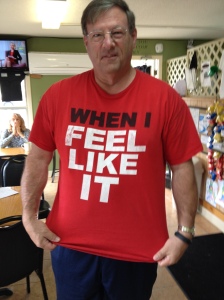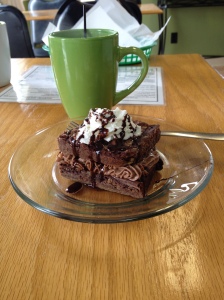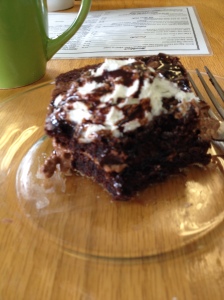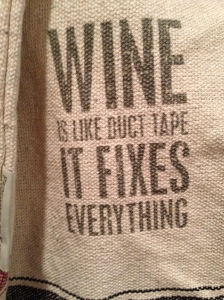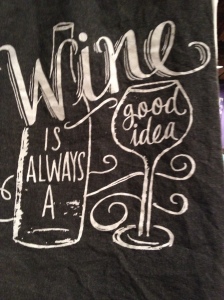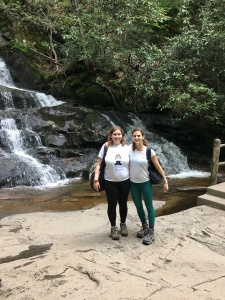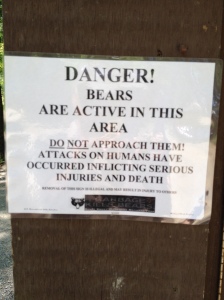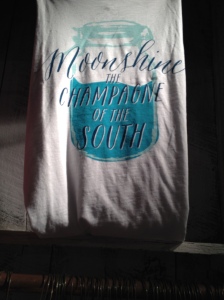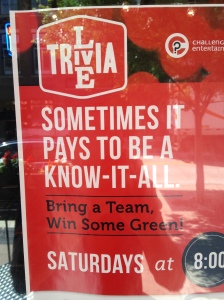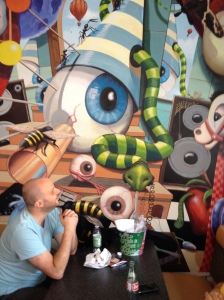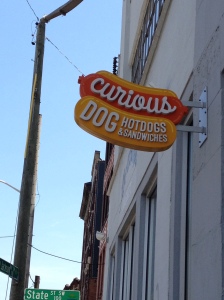Blog Archives
Nature-Deficit-Disorder – by Gary S. Smolker
Posted by Gary S. Smolker
Live A Little
I’ve concluded that life is for living.
I have concluded that the best type of life for me is one in which I stop being afraid of wasting my time by going out or by going to new places or by meeting new people and instead that I should travel to new places, meet new people, have new experiences and learn new things while doing so.
Medicine Is A Way of Life.
In my opinion life is beautiful and how I live my life is either good medicine for me or poisonous.
The key to being “healthy” for me is knowing how to live.
I’ve found I can –
- Be Happy, Healthy and Full of Wonderment.
- Relieve stress, regenerate my spirit, laugh and be joyful.
- Go out in “nature” and see directly in front of my eyes that all living things (plants, animals, fish and fowl] that live naturally in harmony with their nature flourish.
The Great Smoky Mountains National Park
I recently went on a trip to the Great Smoky Mountains National Park in North Carolina and Tennessee with my three adult daughters.
One of the great things I discovered while being high up the Great Smoky Mountains National Park is that there is no cell phone reception there.
Consequently it was a place where I could relax and (re)connect with nature.
While I was in the Smoky Mountains I was able to decompress, relieve stress and regenerate my spirit as a result of being in nature with no distractions – as a result of being in a place where there was no cell phone service.
I personally experienced the value of (a) breathing fresh air, (b) seeing clear clean running water in streams creeks and rivers, (c) seeing picturesque waterfalls, (d) hiking in pristine woods and (e) solitude.
As a result of “being “n nature” without the distractions imposed on me by cell phones, Internet connection, talking texting or emailing I was able to see clearly the way things work “in nature” and as a result of that after I returned from my “retreat” in nature with my daughters I have been able think clearly without distraction about several things of concern to me.
Additionally, my trip to the Smokies was an amazing bonding experience with my daughters, nature and myself.
During the entire time I was in the Smoky Mountains I was happy, healthy, full of wonderment and stress-free.
The kinds of experiences I had on my trip to the Smoky Mountains have provided memories which I will enjoy for years to come and a reference point and base line to use when thinking about things in my daily life that are important to me.
The experiences I had and the observations I made on that trip have increased ability to think many fold about how I spend my time and other resources and about medical, financial, family and emotional issues of great concern to me.
The Area In and Around the Great Smoky Mountains National Park
The whole area in and around the Smoky Mountains is quite stunning – light traffic on the freeways, lush green all around the hills and in the mountains.
“Nature” is preserved in a pristine state in the Great Smoky Mountains National Park.
People Who Know How to Live
The people I met in the areas in and around the Smoky Mountains during my vacation/retreat in the Smoky Mountains with my three daughters know how to live.
They live rustic sensible refined remarkable and somewhat “funky” lives.
Every one I met was good -natured, calm, friendly, hospitable and grounded, and seemed to be alert and happy.
The people I saw and met in cafes, restaurants, and grocery stores during my sojourn in and around the Smoky Mountains were striking different from the people I typically see in similar places in and around Los Angeles.
The people I met in the South (in and around the Smoky Mountains) were all very calm, relaxed and laid back.
I didn’t meet or see anyone during my sojourn in and around the Smoky Mountains who was up tight, anxious, or stressed out.
Below is a photograph I took of a man a man I met in the “Lil Black Bear Cafe” in Pigeon Forge, Tennessee.
I’ve never seen anyone wearing a T-shirt in Los Angeles like the T-shirt the man in the photograph above is wearing.
By the way, the chocolate Bear Claw served in the “Lil Black Bear Cafe” in Pigeon Forge, Tennessee is something to write home about. I ate one. See photos below of the Bear Claw I ate in the “Lil Black Bear Cafe.”
I survived eating the Bear Claw pictured above.
I purchased a T-shirt to celebrate my accomplishment.
See photograph of the T-shirt I bought.
The people I met, and the culture and way of life I observed, in and around the Smoky Mountains was tremendously different from the culture I experience every day in Los Angeles.
I think people in the South (at least the people I met and interacted with) are more “natural” and more in tune with their core human nature that people in and around Los Angels that I see when I go out to eat or to a grocery store or to any other public place in Los Angeles.
Below is a photograph of a man I met in a grocery store in Pigeon Forge, Tennessee and a close up photograph of the T-shirt that man was wearing when I saw and met him.
I’ve never seen anyone in Los Angeles wearing a T-shirt like that.
Popularity of the Great Smoky Mountains National Park
The Great Smoky Mountains National Park is the most popular park in the National Park System.
Ten million people per year visit the Great Smoky Mountains National Park.
Everyone Needs A Perfect Place to Think
Everyone needs a perfect place to think without distraction, a retreat.
The Great Smoky Mountains National Park is such a place.
All four of us (Leah, Judi, Terra and me) found the Smoky Mountains to be a perfect place to think.
My Search for A Clear Mind
The search for a clear mind is one of my fundamental goals.
The search for a “clear mind” is the fundamental goal of “all” creative and highly productive people.
During my trip to the Smoky Mountains, the solitude I experienced and my interaction with (a) my daughters, (b) nature and (c) the people I met gave me a clear mind.
My Trip to the Smoky Mountains
I left my in Encino, California on May 14, 2016 and visited the Great Smoky Mountains in North Carolina and Tennessee for ten days, from May 14 to May 24, 2016, with my three daughters Leah, Judi and Terra.
As a result of taking my trip to the Smoky Mountains, I feel totally connected to life – physically, emotionally, mentally, and spiritually.
It is clear to me that the state of my energy, my health and of my over-all-well-being are dependent on being connected to nature.
The Best Way to Live
Life is about choice.
I advocate relieving stress, being healthy and living a creative down to earth purposeful gratifying meaningful healthy life.
I’ve found that the best way for me to live is by being connected simultaneously with my natural core and nature.
I’ve discovered it is okay for me to enjoy a glass of wine, to have a beer, to have a shot of whiskey; it is not crazy or a waste of my time to go for hikes in woods, to do yoga, to read a book, to think and reflect in solitude, or to go to car shows, or to take photographs with my iPhone of whatever strikes my fancy, and that it is beneficial for me yo travel to new places to meet new people and to see new things.
In my opinion going to new places, meeting new people, connecting to nature, and having new experiences should be part of everyone’s life goals.
As a result of my recent vacation in the Smoky Mountains I have concluded that –
- I will achieve clearer thinking and better health by connecting myself to nature.
- My live is energized by experiencing a sense of oneness in the energy flow I make when I am in the moment.
- My life is about making choices.
- The best “medicine” for me is living the way of right relationship – I found that living a healthy LIFE is about doing that.
Failure and Making Mistakes Are A Natural Feature of Life and of Making Progress and of Making Something New
Creativity is a resource we continually draw upon to make something from nothing, to make the non-existent come into being.
Part of being healthy is to not be afraid of trying something new, or trying to do something new.
Inevitably active alive and creative people experience failure and make mistakes.
Healthy people realize mistakes are not a necessary evil.
Mistakes are an inevitable consequence of doing something new, and as such, they such be seen as being valuable; without them, we’d have no originality.
Mistakes and failures are learning experiences.
Think of failure like learning to ride a bike; it isn’t conceivable that anyone could learn to ride a bike without making mistakes – without toppling over a few times.
Personality Plus
The first place I landed on my way to the Smoky Mountains was in Asheville, North Carolina.
Asheville is known as “Beer City, USA” because it has so many microbreweries.
We went to Asheville first because my daughter Leah is a beer connoisseur.
I saw “good humor” and “personality plus”, and experienced “positive energy” and “social commentary” everywhere I went during my three day stay in Asheville, North Carolina.
The people I met in Asheville had good nature, and were happy, hospitable, calm, and grounded.
It was pleasant to interact with each person I interacted with in Asheville.
Each of them exhibited a good sense of humor.
Below is a picture of a sign I saw posted in the window of the “12 Bones Smokehouse” in Asheville, North Carolina.
That sign made me laugh when I saw it.
By the way, the “12 Bones Smokehouse” is President Obama’s favorite rib joint.
While in Asheville I saw another which made me laugh.
See picture of that sign below.
It is a sign on the wall of a place where you can self-wash your dog.
The Most Famous Place in Asheville, North Carolina: Biltmore House & Gardens
I love chocolate.
During my trip to the Smoky Mountains, I visited the most famous place in Asheville, North Carolina: the Biltmore House.
The Biltmore House was built in 1895 by George Vanderbilt.
It is a 250 room house.
It is situated on a 8,000 acre estate.
It has gardens and trails, a conservatory, a bass pond, a boathouse, lawns and woods.
In “the house” itself, there are restaurants, a courtyard market, a bake shop, a ice cream parlor, and specialized stores for shoppers and highly specialized shopping experiences.
For shopping there is a store called “Christmas Past”, a store called “Bookbinder’s”, a store called “Carriage House”, a store called “Confectionery”, a store called “Toymaker’s”, and a store called “A Gardener’s Place.”
My favorite part of the house is the candy store (the confectionery).
I am a fan of tasty chocolate and good advertising.
My First Most Favorite Experience at Biltmore House
My favorite experience, while I was touring the Biltmore House, was seeing what was printed on boxes of chocolate for sale in the “Confectionery.”
See photos below.
I also love cupcakes.
I was thrilled when I saw the package below in the confectionery, advertising cupcakes, yum.
My Second Most Favorite Experience at the Biltmore House
My second best experience at Biltmore House was looking at the exotic flowers growing in the Conservatory at the Biltmore House.
Below are photographs of exotic flowers I saw growing in the Conservatory at the Biltmore House.
My Third Most Favorite Experience at the Biltmore House
My third best experience at the Biltmore House was looking at a group of flowers growing in a pond above the gardens. Those flowers are shown in the photograph below.
Character and Assertive Individuality Have Been Alive and Well in the Great Smoky Mountains in Eastern Tennessee for Many Years
For various reasons the Great Smoky Mountains have always been a very special place.
The people who lived in the Smoky Mountains in the recent past were famous for hiding their stills from tax collectors and for selling their homemade distilled spirits when it was against US Federal Law to do so.
Being surrounded by natural beauty and making homemade distilled spirits and having a great down to earth sense of humor has been a way of living in and around the Great Smoky Mountains for generations.
When it was illegal to manufacture or sell liquor, certain people [who lived in and around the Great Smoky Mountains in Tennessee were called Moonshiners and also called bootleggers] manufactured and sold homemade distilled spirits nicknamed “moonshine”; they manufactured and sold “homemade” wine and whisky (“moonshine”) in violation of federal law.
Doing that earned them a “romanticized” place in the history of the United States.
Today, it is not against federal law to manufacture or sell distilled spirits.
However, in an attempt to take advantage of romantic and nostalgic feelings about “moonshine” and “moonshiners” , major distillers pretend to sell “moonshine” — and promote the sales of their products (wine and whiskey) with sales messages associating their products to individualistic rebel character traits romantically associated with moonshine and bootleggers.
These messages are printed on ancillary merchandise – soft good items – such as T-shirts, pillows, and dish towels sold in “Moon Shine” stores and boutiques in Gatlinburg and Pigeon Forge Tennessee.
For examples, at their stores in Gatlinburg and Pigeon Forge the “Old Smoky Tennessee Moonshine” company provides free moonshine tastings, live music, distillery tours and sells “moonshine” (jars of whiskey) as well as T-shirts, Sweat Shirts, and sundry other items.
Master Enjoyment of A Glass of Wine Because You Have Worked Hard and Traveled Far
Wine is a symbol.
The wine industry in Tennessee has made a successful effort to have me associate drinking wine with Individuality, Character, Relaxing, Relieving Stress and Being A Fun and Wise Person.
In their boutique wine and whiskey tasting stores near the Smoky Mountains their customer (me) can’t help but associate Being Fun with Drinking Wine, Wine Drinking.
Below are pictures of miscellaneous soft good items imprinted with messages celebrating and encouraging the consumption of wine.
I recently took the pictures below in a so called wine tasting store in Gatlinburg, Tennessee.
Notice that each of the items shown in the photographs below cleverly delivers the message that a person who drinks wine is a fun person.
Each message has a “fun”, “be fun”, “have fun” emotional arc I relate to.
I had “fun” reading each message.
I smiled when I read each message.
I took each of the above photographs on May 23, 2016 at the “Bootleggers Home Made Wine” store in Gatlinburg, Tennessee.
Gatlinburg is a small town located at the foot of the Smoky Mountains in Eastern Tennessee.
The Majesty of Nature
Seeing nature in the Great Smoky Mountains National Park is a spiritual as well as a physical and mental experience.
I can’t imagine any person with sight not being able to visually spiritually and mentally experience the majesty of nature on display in the Smoky Mountains and our deep rooted connection with nature.
Below is a series of photographs I took of the Smoky Mountains behind a layer of clouds I observed from my Majestic View cabin in Pigeon Forge, Tennessee, at 6:30 a.m.
Note: the clouds in front of the Smoky Mountains look like smoke coming up from and rising up from the Smoky Mountains.
Next are photographs I took of the same view from the cabin with the Majestic View four hours later at 10:40 a.m. – after the morning mist and clouds in front of the Smoky Mountains began dissipating, then dissipated and then disappeared.
Below are photos taken later in the day.
Below are photographs I took at sunset while standing on the deck outside the kitchen at my cabin.
More Than 40 Note Worthy Waterfalls
There are over 2,000 miles of sparkling rivers, prongs and branches and over 40 noteworthy falls in the Smoky Mountains.
During our time together in the Great Smoky Mountains National Park, my three daughters Leah (age 28), Judi (age 31) and Terra (age 45) and I hiked together to several of those noteworthy waterfalls.
Below is a series of photographs I took at one of those waterfalls.
The first photograph is of one of those waterfalls.
The second photograph is of my one of my daughters standing next to that waterfall.
The third, fourth and fifth photographs below are photographs of my daughter standing behind that waterfall.
Below is a photographs I took of my two youngest daughters standing in front of another waterfall.
Below is a photograph of my youngest daughter with me in front of that waterfall.
Below is a photograph of me standing in front of that waterfall.
Below is a close up photograph of of the top of that waterfall.
Below is a photograph of another water fall in the Great Smoky Mountains National Park we hiked to.
Sparkling Rivers Prongs and Branches
Professionally taken photographs:
My photographs:
Hiking To Abrams Falls
Below is a picture of my youngest daughter Leah (age 28) Leah took of herself while Leah and I were hiking together through the woods in the Smoky Mountains to Abrams Falls.
It took us five hours of hiking through woods in the Great Smoky Mountains National Park to get to the Abrams Falls.
At Abrams Falls water water with the volume of a river plunges 25 feet into a large pool.
The force of the fall throws spray over 50 feet into rhododendron and hemlock on the bank opposite the trail we hiked on to get to the falls.
The deep pool under the falls has a very strong undercurrent.
A sign near the falls warns people not to swim in the pool under the falls – swimmers have drowned. See sign below.
People are also warned to be aware of bears near the falls. See sign below.
Below is a photograph I took of myself in front of Abrams Falls.
Below is a series of photographs of Abrams Falls.
Messages Printed on T-Shirts Present Moonshine as The Nectar of Pure Unadulterated Living
In Gatinburg, several breweries give free tastings in addition to selling “moonshine (whiskey)”; they also sell T-shirts on which are printed provocative messages.
The photographs below were taken by me in the “Old Smoky Tennessee Moonshine’s” store on the Parkway, in Gatinburg, Tennessee on Monday night, May 23, 2016, after Leah and I finished our hike to Abrams Falls.
Knoxville Vibe
All of us (Leah, Judi, Terra and Me) got back to our homes by flying out of Knoxville Airport.
Leah and I spent the morning looking around the Art District and the Old City District of Knoxville.
Both are very cool places.
Below are photographs I took which express the “come on in” attitude I experienced in and around the Art District in Knoxville, Tennessee.
I Saw Art and Beauty Everywhere During My Trip to the Smoky Mountains
At the Curious Dog in Old City Knoxville, Tennessee
See photograph below I took of a booth in the “Curious Dog” in the Old Town section of Knoxville, Tennessee on May 24, 2016.
Photos below are close ups of sections of the mural in the photograph above.
Photograph of a guy sitting in that booth.
Photograph I took the sign on the exterior street side of the entry door to the “Curious Dog.”
Paintings on the Two Walls in A Dead End Alley in the Old Town Section of Knoxville, Tennessee
While walking around the Old Town section of Knoxville on May 24, 20167, with my daughter Leah, we found ourselves walking down a blind alley, an alley the “dead-ended”, an alley which had no exit.
Below are photographs of paintings I saw painted on the two walls in that alley.
Chair In A Shop in the Chicago O’Hare Airport Terminal
Below is a photograph I took of a chair I saw in a shop in O’Hare Airport, Chicago, Terminal 1, Gate B-6, on May 24, 2016 as I was on my way to catch a connecting flight to Los Angeles International Airport, LAX.
I had started my journey home to Los Angeles from the Smoky Mountains on a flight departing from Knoxville Airport.
My trip home involved taking a plane from Knoxville Airport to O’Hare Airport in Chicago and then catching another plane at O’Hare Airport that flew me back to Los Angeles.
It took over 10 hours to get back home from the time I left the Knoxville Airport to the time my plane landed in Los Angeles at LAX, the airport in Los Angeles.
Art and Beauty Everywhere
On Saturday, June 4, 2016 I went to return a computer to the Apple Store at the Grove — a upscale shopping cent in Los Angeles.
While I was at the Grove I discovered there was an event, an auto show, at the Grove.
By the way, the Grove is located near the intersection of Third Street and Fairfax Avenue in Los Angeles, California.
Of note to me, as a father of three adult women and a lover of women, I saw more women then men looking at the cars on display on the street at the auto show.
So much for the cliche that boys like cars and girls like dolls.
Below are pictures I took of three of the multitude of “classic cars” I saw on the street, on display, as part of the car show at the Grove.
Really interesting: on the top two cars pictured above, the rear view mirror is strapped to the spare tire.
Save Yourself from Nature-Deficit-Disorder, Get Out: Visit The Great Smoky Mountains; Travel to, Visit and Explore New Places
The Smoky Mountains are one of the most bio-diverse places on earth.
According to the National Park Service over 18,000 different types of animals and plants live in the Great Smoky Mountains National Park.
Synchronous fireflies (Photinus carolinus) are one of 19 species of fireflies at Great Smoky Mountains National Park. They are the only species in the Americas whose individuals can synchronize their flashing light patterns.
No one is sure why the fireflies flash synchronously.
The fireflies do not always flash in unison.
They glow in the dark.
They may flash in waves across hillsides, and at other times will flash randomly.
Synchrony occurs in short bursts that end with abrupt periods of darkness.
The Smoky Mountains is also the home of the “American Black Bear.”
More than 1,500 black bears live protected “in the wild” in the Great Smoky Mountains National Park.
More statistics:
- More than 1,500 different specifies of wild flowers are found in the Great Smoky Mountains National Park, more than in any other North American National Park.
- More than 100 different species of trees grow there.
- More than 240 different species of birds have been spotted there.
The Southern Appalachians are one of the temperate zone’s hot spots for plants. North of the tropics, only China has more species.
The climate of the park encompasses a range of conditions from warm to cold temperature, and rainfall is abundant everywhere.
Elevations in the park range from 850 feet to 6,643 feet. As one moves from lower to high elevations the climate becomes cooler and wetter and cloud cover is more frequent.
Rainfall ranges from about 55 inches at low elevations to 90 inches on high peaks.
Differences in elevation and the ruggedness of the mountains – topographical features affect soil moisture – result in a vast variety of environments that produce a wide variety of vegetation.
Slope aspect, slope position and slope shape all combine to determine the amount of sunlight reaching a site, its warmth, and its ability to retain soil moisture.
Even if you stay in a narrow elevation range, the habitat changes dramatically. And because habitat changes, the species of wildflowers and plants you see growing also varies.
As a result of its biodiversity and its closeness to population centers, the Great Smoky Mountains National Park is the most popular park in the National Park System; 10 million people visit the park each year.
The National Park Services maintains 380 miles of scenic roadways, 800 plus miles of trails and bridges, 9 front country campgrounds, and more than 100 back country campgrounds in the Smoky Mountains National Park.
ASIDE:
- The National Cancer Institute and other groups have repeatedly visited the Smokies to take, under permit, small plant samples, looking for new medicines.
- Fully, 25 percent of our prescription drugs contain at least one ingredient taken directly from a higher plant.
- The Cherokee had documented uses for 60 percent of the flora in the Smokies.
- Over 600 species from these mountains were or are still used as medicines by the Cherokee.
- Generations of trial and error of uses of plants in these mountains represent a refined knowledge of plant biochemistry and the potential for use.
- A recent study showed that study of traditional cultural use of plants in an area is a faster route to discovering new medicines than blind screening of all plants in an area.
The prime directive of all national parks is to preserve not only native species, but also the natural processes that maintain them.
This year (2016) the American National Park Service turned 100 years old.
THE ART OF LIVING
I see art everywhere and beauty everywhere.
I can’t wait to tell you about “the Swag” in Waynesville North Carolina; “Lil Black Bear Cafe” in Pigeon Forge, Tennessee; and, “Curious Dog” and a blind alley in Old Town Knoxville, Tennessee, which I will do in a future blog post article on the “Gary S. Smolker Idea Exchange Blog.”
The Swag
Below is a photograph of what I found on my bed when I went to my room at the Swag.
There was also a backpack on my bed. See photo below.
There was a note explaining the materials inside the backpack. See photo below.
On one of the night stands besides the bed was a book of poetry. See photo below.
I adopted “Mr. Rocky”, the Black Bear I found on my bed in my room at “the Swag.”
I can’t wait to tell you more about “the Swag.”
Conclusion
We determine the trajectory of our lives.
We should learn how to see.
We should live with our eyes wide open.
We should travel to places we have never been to before and meet people we have never met before.
Having/enjoying good health is a way of life.
Copyright © 2016 by Gary S. Smolker, All Rights Reserved
Posted in American Black Bear, bio-diversity, bootleggers, Effective Emotional Messages, Life's Goals, Live A Little, Medicine Is A Way of Life, Moonshine, Moonshiners, Nature-Deficit-Disorder, the Great Smoky Mountains, The Nectar of Pure Unadulterated Living, The Way of Right Relationship, Whiskey, Wine, Wine Whiskey and Yoga, Your Soul Is The Center of Your World
Tags: "12 Bones Smokehouse", "Curious Dog", "Lil Black Bear Cafe", "Medicine of the Cherokee", "The Lil' Black Bear Cafe", "The Soapy Dog", "the Swag", Abrams Falls, all gendered BBQ, American Black Bear, art, art and beauty, auto show, beauty, being connected to nature, Biltmore House, bio-diversity, biological abundance, bootleggers, Bootleggers Home Made Wine, botanical knowledge, character, Cherokee, chocolates, classic cars, clear thinking, Conservatory, creative people, creativity, cupcakes, discovering new medicines, do it yourself dog wash, Eastern Tennessee, Effective Emotional Messages, fear, flowers, Gatlinburg Tennessee, George Vanderbilt, health, healty people, highly productive people, Holy Spirit, knowing how to live, Knoxville Tennessee, life, life force, Live A Little, looking for new medicines, Medicine Is A Way of Life, meeting new people, Moonshine, Moonshiners, nature, Nature-Deficit-Disorder, O'Hare Airport Chicago, Old City Knoxville Tennessee, originality, Pigeon Forge, Pigeon Forge Tennessee, plants used as a source of medicine, plants used as medicine to fight diseases, prescription drugs, pristine forests, productive people, pushing towards originality, rebels., refined knowledge of plant biochemistry and the potential for medical use, relatively untouched landscapes, seeing new places, shine a light leading the way, Smoky Mountains, Smoky Mountains National Park, soul, spiritual reflection, Sugar Mama's., T-shirt messages, the American National Park System, the art of living, the confectionery at the Biltmore House in Asheville North Carolina, the Great Smoky Mountains, The Great Smoky Mountains Home of the "American Black Bear", The Nectar of Pure Unadulterated Living, The Way of Right Relationship, the world of nature, travel, values, wellness, Whiskey, wild flowers, Wine, Wine Whiskey and Yoga, yoga, Your Soul Is The Center of Your World
Time-Starved Women In High-Powered Careers – Footnote No. 1 In Gary S. Smolker’s Mentor’s Journal
Posted by Gary S. Smolker
Updated, May 4, 2014
Dear Friend,
Anxiety is the most common mental disorder in America.
Anxiety affects approximately forty million adults.
Depression is the leading cause of disability worldwide.
The World Health Organization has estimated that by the year 2020, depression will become the second largest cause of suffering in the world – next only to heart disease.
In the United Kingdom stress has emerged in recent years as the top cause of illness across the nation; prescriptions for antidepressants have gone up 495 percent since 1991.
In Europe from 1995 to 2009, the use of antidepressants went up nearly 20 percent per year.
In the United States more than 22 million people are using illegal drugs, more that twelve million are using prescription painkillers without a medical reason, and almost nine million need prescription sleep aids to go to sleep.
Thank you for forwarding “health alert” memos and articles on how to live a healthy life to me.
Providing information on how to live a healthier/healthy life is a GIANT business
No-one, myself included, can keep up with all the medical information spewing forth.
In “The Cleveland Clinic Way”, Toby Cosgrove, MD, President and CEO of the Cleveland Clinic, reports, “Medical knowledge today is vast – approximately 1,500 medical articles appear EACH DAY in about 4,000 journals. Individual physicians can master only a small portion of a patient’s care.”
Several “time starved” women have recently complained to me that they have literally been driven to drink, sleep deprivation and depression by the highly stressful pressure imposed on them by one or more men they are “forced” to deal with in their “business lives.”
In one case unhealthful stress producing pressures came from a male ‘business colleague’ forcing a woman he works with to mix social activities with business activities.
In that case (a) a male business colleague insisted that a woman he works with go out and have a drink with him; (b) he insisted that this woman ‘business colleague’ have breakfast “meetings” with champagne at breakfast with him; (c) he also insisted that she have lunch with him with a martini at lunch and (d) that she go out to dinner with him and have wine with him at dinner.
In that particular case the woman did not want to go out to eat with this male and/or to drink alcohol and believes that such “meetings” were a waste of her time.
She finally refused to have any further meetings with that man.
I want my daughters, my women friends and the world at large to know they are paying costs to their physical and mental well-being when they experience emotional stressors that make them unable to sleep and/or which cause them to become depressed and that those health costs are unsustainable.
In “Strive” (published in 2014), Arianna Huffington tells us:
- Women in highly stressful jobs have a nearly 40 percent increased risk of heart disease and heart attacks compared with their less-stressed colleagues, and a 60 percent greater risk for type 2 diabetes (a link that does not exist for men, by the way).
- Women who have heart attacks are always twice as likely as men to die within a year of the attack, and women in high-stress jobs are more likely to become alcoholics than women in low-stress jobs.
- Stress and pressure from high-powered careers can also be a factor in the resurgence of eating disorders in women ages thirty-five to sixty.
- Stress leads to higher instances of diabetes, heart disease and obesity.
- Sixty to ninety percent of doctor visits in the United States are to treat stress-related conditions.
In “Wheat Belly” William Davis, M.D. advises us:
- The personal and societal costs of developing diabetes are substantial.
- On average, one person with diabetes incurs $180,000 to $250,000 in direct and indirect health carte costs if diagnosed at age fifty and dies eight years earlier than someone without diabetes.
In “The Cleveland Clinic Way” Toby Cosgrove, M.D. observes that:
- “Almost a hundred years ago, the founders of group practices were struck by the complexity of modern medicine and the consequent need for collaboration across specialties.
- “Cleveland Clinic founder Dr, George Crile observed that a modern-day doctor is no more able to undertake intricate patient problems alone than to build a car alone.
- “When patients get sick, they typically have to visit numerous specialists to get proper treatment.
- “One study found that between 2000 and 2002, the typical Medicare beneficiary with a chronic condition such as diabetes or heart disease saw up to 16 physicians in the course of a year, not to mention pharmacists, imaging technicians, and other specialists.”
- Anxiety is the most common mental disorder in America. Anxiety affects approximately forty million adults.
- Depression is the leading cause of disability worldwide.
- The World Health Organization has estimated that by the year 2020, depression will become the second largest cause of suffering in the world – next only to heart disease.
It is common sense that one must get enough sleep and manage emotional stress, anxiety, and worry in their lives, i.e. by expelling nerve-racking [literally] ingredients from their lives.
But, that is easier said than done.
Thank you again for sending me a copy of an article on how doing the right type of yoga is good for your health.
Gary
If you want big success, build a business that responds to big trends – Ongoing Trends that Are Changing the Practice of Medicine and People’s Health and Making Many People, Companies and Organizations Feel Good About Themselves, Healthier and Wealthier
Posted by Gary S. Smolker
Copyright © 2014 by Gary S. Smolker
Updated April 25, 2014
America cannot afford to spend as much money as it will be spending if Americans keep on becoming sicker and sicker.
Since there is a dispute about what course of action to take (what path to follow) among scientists, physicians, health experts, and healthcare experts we need to get a grip on our predicament.
Science is not decided by vote.
Science is not decided by consensus.
There is only our best current understanding.
If the “Big Names” had it right we would be living on a flat Earth around which the universe revolves praying to Zeus for our lives.
Business People Are Responding to Our Anxiety and Fear About Our Health
Many professionals – who are businessmen with a variety of credentials – have “jumped-in” to tell us how to live long healthy productive lives and have written books and are giving lectures which promise to fill in the gaps in our knowledge and understanding with information we need.
Other business people have jumped in (either as “idealists”, or “capitalist” – to “milk” our anxiety and fear about being “healthy”) by starting companies that “grow good healthy food”, “sell healthy food”, “serve healthy food”, give nutritional advice, give Yoga lessons, etc.
None of the “author experts” whose books I review in this article suggest that we pray to Zeus for good health, or to lose weight.
However, (a) reading what experts/authors have written, (b) listening to what lecturers on “health and healthy living” say, and/or (c) listening to what your own personal physician(s), nutritionists, dietitian, trainer and/or friends and colleagues tell or advise you to do might leave you confused.
Be that as it may be, life is action.
You are going to do something.
If you want to be healthier and/or to keep your health
- it is up to you to make a change based on what you decide makes the best sense for you to do, or
- you may “blindly” do what someone else tells you to do, or
- you may continue to do what you are presently doing now.
Those are your choices.
I have a modest proposal.
Call to Action
You and I realize, if we want to change our health, we need to change our habits.
We realize, change is a matter of choice.
We are told by a multitude of people that Americans need to adopt a cultural shift away from treating sickness and disease and toward preventing them.
We are bombarded with messages promoting a culture of wellness.
We are bombarded with messages telling us we – the American people – are getting sicker and sicker, our healthcare costs are skyrocketing, we are becoming fatter and fatter, we are becoming more and more stressed out and more and more sleep deprived and we waste a lot of time on the Internet, or on our smart phones, and that we don’t get enough exercise.
We are told that we have been sucked into a vicious cycle of becoming more and more unhealthy and sicker and sicker and sicker.
We are told we need to break out of that vicious cycle.
I, for one, have concluded that I need to think about and decide what I and the rest of us can do and what I want to do to keep my health and to become healthier.
I have asked myself: “Do poor habits pose a dire health problem that I am willing to try to fix or that anyone would be willing to fix?”
Do Poor Habits Pose A Dire Health Problem?
In “The Cleveland Clinic Way” Toby Cosgrove, MD, President and CEO of Cleveland Clinic, says the facts facts tell the story.
- Despite widespread antismoking campaigns, about a fifth of Americans still smoke, and some 4,000 people under the age of 18 try their first cigarette each day.
- Only 13 percent of American men and 9 percent of American women report that they exercise vigorously for 10 minutes or more five or more times per week. The vast majority of Americans never break a sweat.
- Most Americans eat the wrong foods – and too much of them.
- All of this leads to an epidemic of obesity.
- According to the National Institutes of Health, some 63 million Americans now qualify as obese, defined as having a body mass index (BMI) of 30 or more. BMI is calculated as a function of height and weight.
- Of these, 3 million are described as being superobese, or 100 pounds or more above their normal weight.
- Obesity like smoking is taking a severe toll on the American population.
- The Centers for Disease Control and Prevention identifies tobacco use, poor diet, physical inactivity, and alcohol abuse as the leading factors in American death statistics.
- Infections and viruses, by comparison are way down the list.
- It’s true that deaths from heart disease have decreased – from 203 per 100,000 people in 1979 to 135 per 100,000 people today. The reduction has resulted from improved treatments, preventive care, and heightened awareness of the major risk factors, such as (a) smoking, (b) inadequate exercise and (c) eating the wrong foods.
- Yet heart disease remains the leading cause of death among men and women, affecting 16.5 million Americans.
- The American Heart Association estimates that about every 34 seconds, an American will have a heart attack.
- In addition, the lifetime risk of having cardiovascular disease after age 40 is two in three for men and more than one in two for women.
- Meanwhile, rates of other chronic illnesses remain high or are trending upward.
- Rates of diabetes have more than quadrupled sine 1990.
- Obesity may be responsible for up to a quarter of some of the most common and deadly cancers, including gallbladder, ovarian, and pancreatic cancer.
- Americans have everything they need to save themselves.
- But, it requires Americans to adopt a cultural shift away from treating sickness and disease and toward preventing them and promoting a culture of wellness.
- Michael Rozen, Cleveland Clinic’s chief wellness officer likes to point out, people who stop smoking before age 35 can live just as long as someone who never smoked. Regular exercise in middle to late life decreases the risk of heart attack by 55 percent, the risk of dying from cancer by 45 percent, and the risk of dying by infection by 95 percent. The overall death rate drops 60 percent. Studies have shown that even people in their eighties see a benefit.
- Some people may see their bodies decline very little (if at all) over time.
- The key is how well they take care of themselves.
- Before age 35, a person’s genes largely account for a person’s overall health.
- After 35, a person’s health is mainly within their control.
- By adopting a few healthy daily habits people can live near or at the top of the health curve for a good part of their life.
In “The Daniel Plan” Rick Warren, D. Min., Daniel Amen, M.D. and Mark Hyman, MD report,
“One in two Americans suffer from some chronic disease. Heart disease; diabetes; cancer; dementia; autoimmune diseases; allergies; acid reflux; irritable bowels; neurological problems; depression; attention deficit hyperactivity disorder; thyroid, hormonal, and menstrual problems; skin problems including eczema, psoriasis, acne, and more. We spend almost $3 cotillion a year in our healt care system, and almost 80 percent of that is for chronic lifestyle preventable and reversible disease.”
In “Strive” Arianna Huffington reports:
- “Higher levels of stress can lead to higher instances of diabetes, heart disease, and obesity.
- “According to the Centers for Disease Control and Prevention, fully three-quarters of American health care spending goes toward treating such chronic conditions.
- “The Benson-Henry Institute for Mind Body Medicine at Massachusetts General Hospital estimates that 60 to 90 percent of doctor visits are to treat stress-related conditions.
- “In the United Kingdom, stress has emerged in recent years as the top cause of illness across the nation.
- “Burnout, stress and depression have become worldwide epidemics.
- “In the United Kingdom, prescriptions for antidepressants have gone up 495 percent since 1991.
- “In Europe, from 1995 to 2009, the use of antidepressants went up nearly 20 percent per year.
- “In the United States more than twenty-two million people are using illegal drugs, more than twelve million are using prescription painkillers without a medical reason, and almost nine million need prescription sleep aids to go to sleep. And the percentage of adults has gone up 400 percent since 1988.
- “Women in highly stressful jobs have a nearly 40 percent increased risk of heart disease and heart attacks compared with their less-stressed colleagues, and a 60 percent greater risk for type 2 diabetes.
- Women who have heart attacks are almost twice as likely as men to die within a year of the attack, and women in high-stress jobs are more likely to become alcoholics than women in low-stress jobs.”
It is easy to let technology wrap us in a perpetually harried, stressed-out existence.
“In fact, one of the legal defenses offered by Steve Cohen, CEO of SAC Capital, the hedge fund that was indicted in 2013 and agreed to a record $1.2 billion fine, was that he missed a warning about insider trading because of the one thousand e-mails he gets every day.”
The Big Picture
In books reviewed in this article, author-experts argue that every bite of food you take is a small but important choice: every bite of food you eat either increases or decreases your odds of living a longer healthier life.
The authors of these books point out that there are diets that lead to obesity, diabetes, heart attacks, stroke, cancer and dementia.
There are other diets that lead to weight loss and a healthier life.
The Bigger Picture
For the first time in history, while millions of people suffer from not having enough to eat, millions are struggling with the effects of being overweight.
Today, as many people are suffering from the result of too much food as malnutrition.
Diabetes, heart disease, stroke, Alzheimer’s disease, cancer and other “lifestyle-based diseases” now kill more people than infectious diseases.
The next time you are with two friends, consider that two of the three of you are likely to die from heart disease or cancer.
The Centers for Disease Control and Prevention identifies tobacco use, poor diet, physical inactivity, and alcohol abuse as the the leading factors on American death statistics.
Behavior-related factors, including tobacco use, poor food choices, excessive portion sizes, and physical inactivity, now account for 75 percent of all healthcare costs.
Preventable chronic diseases are responsible for 81 percent of all hospital admissions in the United States, 91 percent of all prescriptions, and 76 percent of all physician visits.
Because of preventable chronic diseases, America spends twice as much on healthcare as Europe and Canada do and four times as much as Mexico, Japan and India.
The United States also has 80 percent more high blood pressure, 110 percent more heart disease, and 800 percent more strokes than other developed countries.
Seven in ten Americans are overweight.
Type 2 diabetes, hypertension, cardiovascular disease, and many types of cancer are not mysterious disease that come out of nowhere.
They are largely caused by our own lifestyle choices.
In “Wheat Belly” William Davis, M.D. advises us:
- The personal and societal costs of developing diabetes are substantial.
- On average, one person with diabetes incurs $180,000 to $250,000 in direct and indirect health carte costs if diagnosed at age fifty and dies eight years earlier than someone without diabetes.
- Diabetes is a disease caused in large part by food.
- Adult diabetes through the ages was mostly the domain of the privileged who didn’t have to hunt for their food, farm the land, or prepare their own meals.
- Only during the last half of the nineteenth century and into the twentieth century, when sucrose (table sugar) consumption increased across all societal levels, common laborer on up, did diabetes become more widespread.
- Today, diabetes is epidemic. The number of Americans with diabetes is growing faster than any other disease condition with the exception of obesity (if you call obesity a disease).
- The explosion of diabetes and prediabetes has been paralleled by an increase in people who are overweight and obese.
- Actually, it would be more accurate to say that the explosion of diabetes and prediabetes has been in large part caused by the explosion in overweight and obesity.
- The fatter Americans become, the greater the number that develop prediabetes and diabetes.
- Weight gain is predictably accompanied by diabetes and prediabetes, though the exact weight point at which they develop can vary from individual to individual.
- Some estimate show that, over the next twenty years, an incredible 16 to 18 percent of all healthcare costs will be consumed by health issues arising from excessive weight: not genetic misfortune, birth defects, psychiatric illness, burns, or post-traumatic-stress disorder from the horrors of war -no, just getting fat.
- The cost of Americans becoming obese dwarfs the sum spent on cancer.
- More money will be spent on health consequences of obesity than education.
In “The Cleveland Clinic Way” Toby Cosgrove, M.D. observes that:
- “When patients get sick, they typically have to visit numerous specialists to get proper treatment. One study found that between 2000 and 2002, the typical Medicare beneficiary with a chronic condition such as diabetes or heart disease saw up to 16 physicians in the course of a year, not to mention pharmacists, imaging technicians, and other specialists.
- “Almost a hundred years ago, the founders of group practices were struck by the complexity of modern medicine and the consequent need for collaboration across specialties.
- “Cleveland Clinic founder Dr, George Crile observed that a modern-day doctor is no more able to undertake intricate patient problems alone than to build a car alone.”
According to the books reviewed in this article, many people today are at a fork in the road with two paths:
Path One
- If people with poor eating habits and life style habits take continue along that path they will have a future of pain and mental deterioration.
- If they don’t take care of their brain and body and just keep doing what they’ve always done, in the future they will have brain fog, memory loss, be depressed, be tired, and have physical illness.
- Sadly this has already happened. Among today’s older adults, most have at least one chronic disease, and at least one in four has two or more.
- According to the Administration on Aging, more than 40 million Americans are currently aged 65 or older.
- By 2030, the number of Americans who are over 65 will more than doubled from their number in 2000, to almost 20 percent of the population.
- Because of poor living habits in the past, many elder Americans are suffering from Alzheimer’s disease and other age-related neurodegenerative diseases; their bodies have outlived their brains.
- Alzheimer’s disease currently affects an estimated 5.2 million people, costs the United States about $200 billion, and is the sixth leading cause of death.
- Doctors aren’t sure exactly what causes Alzheimer’s disease, but they do know that Alzheimer’s shares major risk factors with cardiovascular disease, such as obesity, smoking and a sedentary lifestyle.
Path Two
- If people take the path of caring for their body and their brain they will increase their chances of having mental clarity, better energy, a brighter mood, great memory, a trimmer and healthier body, healthier skin, a healthier brain and not dying from a heart attack or stroke or cancer or diabetes or Alzheimer’s disease sooner than later in the future.
The Path Being Taken by Big Business
Ill health is costly to corporate profits.
Americans today are so unhealthy, and ill health is so costly to corporate profits and the need for Americans to become more healthy is so great that most big businesses have adopted programs aimed at improving the health of their employees.
According to a 2013 survey by the National Business Group on Health, an association of large employers, about 93 percent of U.S. employers have some kind of wellness program — an umbrella term that encompasses everything from in-house yoga to help quitting smoking.
Eighty percent of those companies also offer health exams to their employees, according to a study last year by the RAND Corporation. They typically give employees incentives to participate, and the Affordable Care Act has boosted the size of such incentives.
In “Strive” Arianna Huffington reports:
- “Studies show that U.S. employers spend 200 to 300 percent more on the indirect costs of health care, in the form of absenteeism, sick days, and lower productivity, than they do on actual health care payments.
- “In the United Kingdom, stress results in 105 million lost workdays each year.
- “Germany lost fifty-nine million workdays to psychological illness in 2011.
- “Right now, about 35 percent of large and midsize U.S. employers offer some sort of stress-reduction program, including Target, Apple, Nike and Procter & Gamble.”
There Is Controversy and Debate About the Impact of Cholesterol Levels on Health
According to most doctors, high cholesterol is a risk factor for Alzheimer’s disease as well as a major risk factor for heart disease and heart attacks.
However, according to neurologist David Perlmutter, MD, cholesterol is not a major risk factor for Alzheimer’s disease, for heart disease or for heart attacks.
Dr. Perlmutter’s thoughts about cholesterol, heart attacks and Alzheimer’s disease are discussed in his recently published book “Grain Brain”, published in 2013.
In “Grain Brain”Dr. Perlmutter claims:
- Cholesterol is at most a minor player in coronary heart disease and represents and extremely poor predictor of heart attack risk. Over half of all patients hospitalized with a heart attack have cholesterol levels in the “normal” range. The idea that aggressively lowering cholesterol levels will somehow magically and dramatically reduce heart attack risk has now been fully and categorically refuted. The most important modifiable risk factors related to heart attack risk include smoking, excess alcohol consumption, lack of aerobic exercise, over-weight, and a diet high in carbohydrates.
- Cholesterol is one of the most critical chemicals in human physiology, especially as it relates to brain health, The best lab report to refer to in determining one’s health status is hemoglobin A1C, not cholesterol levels. It is rarely, if ever, appropriate to consider high cholesterol alone to be a significant threat to health.
- Studies dating back to the mid-1990s reveal a link between statin use and an increased risk of certain cancers, not to mention a long list of side effects from digestive challenges to asthma, impotence, inflammation of the pancreas, and liver damage, A trial published in January 2010 in the American Journal of Cardiology found that statin medications actually increased the risk of death. Researchers in Israel followed nearly 300 adults diagnosed with heart failure for an average of 3.7 years, and in some cases up to 11.5 years. Those who were taking statin drugs and had the lowest levels of low-density lipoprotein (LDL) were found to have the highest rates of mortality. Conversely, people with higher levels of cholesterol had a lower risk of death.
- The benefits of statins are questionable, and major studies have failed to show how they protect the body from illness.
- However, Dr. Perlmutter does state in “Grain Brain”: numerous studies do point to the positive effects statins have on reducing mortality rates in people with coronary artery disease. [Emphasis added.]
I Would Like to Know the Answer to the Following Two Questions:
- Has the evidence in those studies been interpreted correctly?
- Do those studies prove anything beyond a reasonable doubt?
A eyebrow raising cartoon first published in 2004 shown in “Grain Brain” (which was published in 2013) reminds us of the evolving state of knowledge about what to heat and what not to eat.
In this cartoon a physician is shown telling his patient, “The high-carb diet I put you on twenty years ago gave you diabetes, high blood pressure, and heart disease. Oops.”
An article published on March 18, 2014 in the Annals of Internal Medicine reports that a team of international scientists, lead by Dr. Rajiv Chowdhury, a cardiovascular epidemiologist in the department of public health and primary care at Cambridge University, found no evidence that eating saturated fat increased heart attacks and other cardiac events.
The new research did not find that people who ate higher levels of saturated fat had more heart disease than those who ate less. Nor did it find less disease in those eating higher amounts of unsaturated fat, including monounsaturated fat like olive oil or polyunsaturated fat like corn oil.
For decades, health officials have urged the public to avoid saturated fat as much as possible, saying it should be replaced with unsaturated fats in foods like nuts, fish, seeds and vegetable oils.
“My take on this would be that it’s not saturated fat that we should worry about” in our diets, said Dr. Rajiv Chowdhury, the lead author of the new study.
This study (published on March 18, 2014 in the Annals of Internal Medicine) has set off a flurry of debate questioning the conclusions of the study and back-peddling by experts who have been urging people to avoid saturated fat (dairy, meet and eggs).
However before that article was published both William Davis, M.D. (in his best selling book published in 2011, “Wheat Belly”) and David Perlmutter, M.D. (in his best selling book published in 2013, “Grain Brain”) challenged the accepted wisdom that saturated fat is inherently bad for you and gave the “green light”to eating more steak, butter and other foods rich in saturated fat.
Although You Are Never Going to Change Human Nature You Might Alter the Environment in which It Is Expressed
We/you don’t want to be gameable and we don’t want to be gamed.
The Role of Prevention
More and more people realize, they have not done what is necessary to prevent disease.
They realize that prevention, not treatment once illness has begun, is key to optimal health and longevity.
With each passing day, more and more people recognize that in order to reach their optimal health they need to change their life style, they need to change how they live.
They realize they need to design a dietary and exercise protocol that suits their needs.
They realize they need to proactively care for their body and mind and that in order to do so they need to
- undergo the blood tests and screenings appropriate for their age, particular circumstances and medical history,
- raise their awareness about the things they do today that affect their tomorrows,
- gain the knowledge they need to take advantage of modern science and medicine,
- find out what is right for them, what works for them,
- know how to live healthy,
- think through their live style choices,
- develop goals that deal with longevity,
- devise a plan,
- set milestones,
- set measures they will take to get to their goals,
- develop healthy habits, and
- follow a comprehensive long-term health strategy.
They also realize there is no “one size fits all medicine.”
Most of us are going to die at a ripe old age or sooner if we don’t take preventive measures.
Change Is A Matter of Choice
Change is a matter of choice.
You can’t passively sit around doing nothing and expect your life to get better.
Ultimately, you must act to take better care of yourself, i.e. stop eating foods that harm you; dump junk food; stop living a sedentary life and reduce stress in your life.
Many people, including bottom-line oriented businessmen, are making (and/or want to make) an effort to experience a whole new level of wellness and better health.
Astute businesspeople/employers now recognize they [the employer] will benefit if they help their employees become healthier.
In her latest book (“Strive”, published in 2014), Arianna Huffington advises:
- “Right now about 35 percent of large and midsize U.S. employers offer some sort of stress-reduction program, including Target, Apple, Nike and Procter & Gamble.
- “At Aetna, the third-largest health insurance provider in the United States, CEO Mark Bertolini discovered the health benefits of meditation, yoga, and acupuncture while recovering from a horrible ski accident that left him with a broken neck. He proceeded to make them available to his forty-nine thousand employees and brought in Duke University to conduct a study on the costs savings. The results? A 7 percent drop in health care costs in 2012 and sixty-nine minutes of additional productivity per day for those employees who participated in Aetna’s wellness programs. And doing yoga one hour each week reduced stress among employees by one-third.
- “Ray Dalio, the founder of Bridgewater, one of the largest hedge funds in the world, who has been meditating for more than thirty-five years and considers it ‘the single most important reason’ for his success, pays for half of his employees’ meditation classes and picks up the entire bill if they commit to it for more than six months.
- “Increasingly, companies are realizing that their employees’ health is one of the most important predictors of the company’s health, as well. In those all-important Wall Street conference calls, business analysts, in addition to asking about sales reports, market share, and earnings, should be quizzing CEOs about their employees’ stress levels.”
In “The Cleveland Clinic Way”, Toby Cosgrove, MD, President and CEO of Cleveland Clinic, advises of steps the Cleveland Clinic and other companies have taken to assist their employees live a healthier life.
The “wellness movement” provides a fabulous/fantastic business opportunity to alert business people.
One of the books I review in this article, “The Daniel Plan” by Rick Warren, D. Min., Daniel Amen, M.D., and Mark Hyman, M.D., argues that people are unhealthy because the food they choose to eat is harmful to them.
Below are some “ideas”/”facts”/”opinions” set forth in “The Daniel Plan”, I think about constantly.
Food has the power to harm you/me.
What you/I put on your/my fork determines whether you/I are/am sick or well, slim or fat, depleted or energized.
Processed food (packaged food) and sugar are our enemies.
Since 1980, more than 600,000 packaged and processed foods have been introduced into the marketplace.
Eighty percent of them are full of sugar.
Since low-fat dietary recommendations in the early 1980s, we have doubled our rates of obesity in adults and tripled it in kids, and the rate of type 2 diabetes around the world has increased sevenfold.
In fact, today in America, one in two people have pre-diabetes or type 2 diabetes.
We have seen the number of people with heart disease, type 2 diabetes, cancer, dementia, depression and infertility skyrocket.
Actually, to diagnose cancer, doctors give patients radioactive sugar. The sugar then goes to the cancer and lights up on the PET scan.
Sugar triggers a cascade of changes in your body that make you sick and fat.
Here is what happens:
- You eat quickly absorbed sugar or refined carbohydrates (like white flour).
- Your blood sugar spikes.
- Your insulin levels spike.
- Insulin triggers the storage of fat in the belly and increases your appetite and sugar cravings.
- The sugar (particularly the fructose in high fructose corn syrup) turns into a cholesterol factory in your liver (called lipogenesis), increasing LDL [sometimes called bad cholesterol], lowering HDL [sometimes called good cholesterol], and raising triglycerides.
- This leads to fatty liver (now affecting 60 to 90 million Americans).
Hunter-gather populations consumed about 22 teaspoons of sugar a year; now the average American consumes 22 to 30 teaspoons every single day.
In 1800, the average person consumed 5 pounds of sugar per year; now we average 152 pounds.
I have lots to say about the current state of what is going on in people’s mind about health, diet and exercise and the response of pioneering business people to the health tragedy caused by people being confused and/or not being able to figure out what is the right thing to do.
Consider based the following “facts” about soft drinks/processed food presented in “The Daniel Plan.”
The average 20-ounce soda has 15 teaspoons of sugar.
Sugar sweetened drinks like soda now make up 15 percent of the calories consumed by the average American.
One can of soda a day increases a kid’s risk of obesity by 60 percent and a women’s chance of getting diabetes by more than 80 percent.
Sugar is more addictive than cocaine.
In “The Daniel Plan”, Dr. Mark Hyman advises:
One of the things you can do to dramatically improve your health and lose weight is “don’t drink liquid calories.’
This means don’t drink soda, sports drinks, flavored coffees or teas, energy drinks and juices, except fresh-made green vegetable juice.
Diet drinks are not good substitutes for sugar-sweetened drinks. They also increase cravings, weight gain, and type 2 diabetes. And, they are addictive.
Our processed, low-fiber, high-sugar diet alters the bacteria that live in our digestive system. There are 500 species of bacteria in there.
The bacteria outnumber our cells 10 to 1, and we have 100 times more bacteria DNA in us than our own DNA.
We live in a “processed food” toxic nutritional wasteland.
- When we eat processed food, we change our gut flora (bacteria) and foster the growth of bad bacteria that promote inflammation.
- Bread, ketchup, and salad dressings are full of sugar.
- The average serving of commercial spaghetti sauce has more sugar than a serving of chocolate sandwich cookies.
If “being healthy” was all about “eat less” and “exercise more”, we would all do it and be skinny and “fit.”
Getting to a state of being “fit” and “healthy” is more complicated then that.
Dr. Hyman reports:
“I had to eat an MRE – meals ready to eat – while I was working after the earthquake in Haiti. When I read the label of the chicken and dumplings, there were more than 500 ingredients I recognized almost none of them and couldn’t pronounce most of them, In fact, I couldn’t find chicken on the label – it was a ‘chicken-like substance.’
In the material which follows, I chronicle/discuss what “informed people” are doing to become fit and healthy.
I also chronicle and discuss pioneering intelligent businesses’ and business people’s actions in response to the widely growing public awareness that what we put in our mouths to eat will determine whether we we will be sick or healthy, depleted of energy or energized, able to concentrate or be confused and suffer from brain fog.
This is a significant trend.
There is a confluence of many forces, which I call “the health movement.”
In “Mission in A Bottle” Seth Goldman and Barry Nalebuff state they started “Honest Tea” in 1997 because all the bottled teas on the market were too sweet.
- The average commercially available bottled tea had twelve teaspoons of sugar in a 16 ounce bottle.
- The World Heath Organization advised: “Consume no more than 10 teaspoons of added sugar per day.”
- Although they had no experience in beverage industry, they (Goldman and Nalebuff) decided to launch a company that made bottled tea with only 2 teaspoons of sugar in it.
- They built something they believed in.
- Ten years later, they sold their company (Honest Tea), for a reported price of $40 million, to the Coca Cola Company.
- Today you can find Honest Tea’s beverages in 100,000 retail outlets.
In “The Daniel Plan”, Pastor Rick Warren reports that in 2010 he realized he was severely overweight. The next day, he stood before his congregation and made this public confession:
“Friends, I’ve been a poor steward of my health and a terrible example for you. While we’ve been helping many around the world, I’ve ignored a problem at home.
“So today I am publicly repenting, and I ask for your forgiveness! God expects us to take care of the bodies he has given us, but I have not done that. Now, I’ve only gained two or three pounds a year, but I have been your pastor for thirty years. So I need to lose ninety pounds. Do any of you want to join me in getting healthy.”
The audience responded with sustained applause.
He was overwhelmed, when in the first few weeks more than 12,000 people signed up to join him in his quest to get healthy.
We Are Living in the “Age of Insight”
In “The Daniel Plan”, Rick Warren, D. Min., Daniel Amen, M.D. and Mark Hyman, M.D. point out “the National Institutes of Health spends $800 a year trying to discover the cause of obesity.”
They (Warren, Amen, and Hyman) then ask, “Could it be the 29 pounds of French fries, 23 pounds of pizza, 24 pounds of ice cream, 53 gallons of soda, 24 pounds of artificial sweeteners, 2.7 pounds of salt, 90,000 milligrams of caffeine consumed every year by the average American.”
According to the Center for Disease Control more than two thirds of Americans are overweight or obese.
Being obese leads to many health problems, including diabetes.
The fatter Americans become, the greater the number that develop diabetes.
The number of Americans with diabetes is growing faster than any other disease condition with the exception of obesity, if you call obesity a disease.
How did we get to the point where seven out of ten Americans are overweight and diabetes is as common as gossip?
Some estimates show that over the next twenty years sixteen to eighteen percent of all health care costs will be consumed by health issues arising from excess weight; more money will be spent on the consequences of obesity than on education.
Physicians should rejoice in conveying information that empowers individuals to take control of their own health.
Have you ever told your physician that you have decided to get healthy to live a healthier life, or asked any physician one of the following questions or had the following conversation with your physician?
- I have decided to get healthy. What can you do to help me successfully answer the challenge of getting healthy, the challenges of improving my health and the quality of my life that goes with healthier living?
- I would like you to coach me in getting healthy and help me design a plan for getting healthier. Are you up to coaching me in getting healthier and designing a plan – a lifestyle program – to improve the quality of my life?
- What are you prepared to do to enable me to successfully live a healthy and healthier life?
- What can you do to enable me to avoid having a heart attack? By the way, in “Prevent and Reverse Heart Disease”, Caldwell B. Esselstyn, Jr., M.D. claims it is possible to prevent and reverse heart disease and presents a specific plant based nutrition program for doing so. Dr. Esselstyn claims people who follow his program have become heart attack proof, their heart disease either stopped progressing or was reversed and they did not subsequently have a heart attack and will not have a heart attack.
- What are you prepared to do to enable me to avoid having a heart attack?
- What can you do to enable me to avoid having diabetes? By the way, in “Dr. Neal Barnard’s Program for Reversing Diabetes”, Neal D. Barnard, M.D. claims that diabetes is not an irreversible condition. It is possible to repair insulin function and reverse type 2 diabetes by following his nutritionally based program. By closely following Dr. Barnard’s program you can cut back on diabetes medications, if not eliminate them completely and reduce your risk of diabetes complications. His program is a method for preventing, controlling and reversing diabetes. His program zeros in on the type of food you eat. According to Dr. Bernard, that is the critical factor.
- What are you prepared to do to enable me to avoid having diabetes?
- What can you do to enable me to avoid having Alzheimer’s disease? What are you prepared to do to help me avoid having Alzheimer’s disease, to enable me to avoid having diabetes? Various physician authors claim, in the books reviewed in this post/article, that the same things you can do to prevent and/or to reverse heart disease will lower the risk Alzheimer’s disease, stroke and diabetes.
- What can you do to enable me to avoid having high blood sugar levels? It is claimed that following Dr. Barnard’s nutritionally based program is three times more effective at controlling blood sugar levels than the standard dietary regime for people with diabetes that has been followed for decades.
- What are you prepared to do to enable me to avoid having high blood sugar levels, to control my blood sugar levels?
- Are you able, and if so willing, to restructure the information provided in current medical reports prepared by testing laboratories and sent to you to provide higher-value information and to provide such higher-value information in written report form to me?
Have you ever wondered why you can see more practical relevant information related to a car on the dashboard of a recent model automobile than you can learn about the status of your body or about your health from any device or software your physician has advised you to use?
I can ask my car questions (i.e. how to get from one place to another) and get intelligent answers (i.e. a map with a route specifying how to get from a starting point to a desired end-point as well as oral instructions on when and where to turn as I take the route calculated by my car).
I can see on a screen on the dashboard of my car the tire pressure in each tire, the oil level, the level of fuel in my gas tank, the outside temperature, speed, etc. etc. etc.
My car (a 2013 Nissan GTR) posts a message on a screen on the dashboard when the tire pressure is too low and when my car needs maintenance.
My car senses and analyzes car performance factors and integrates and uses that information to calculate and post on the dashboard how many miles per gallon I am getting while driving as well as an estimate of how many more miles I can drive before I run out of gas.
Almost all of us know more about how to keep our cars running (for 200,000 plus miles) than how to keep our bodies, minds, and souls healthy for a lifespan of 120 years.
Ancient cultural knowledge about how to create and maintain health has not been widely available because western medical schools don’t teach this and conventional western medical doctors and nutritionists don’t learn this.
However, our ability to access, understand and learn from data has been transformed by the widespread use of smart phones and computers and the creation of new sensors, new software and new electronic devices.
We know we can get “the answer” from technology; we only need to have the right devices and then to decide what to ask.
We are transitioning from the “Age of Information” (currently called the “Information Age”) to the “Age of Insight.”
That being said, if you are not afraid to do so, ask your physician (a) to advise you of the availability of sensors and wireless communications using smart metering/monitoring software that will gather, store and integrate/crunch/analyze and track the status of information your body now generates at all times and how you may exploit that information and (b) to answer any or all of the questions listed above.
At a minimum, consider having your medical records stored on an electronic device so that your medical records can be accessed and electronically distributed at any time from any place.
In the Past, Effort At Trying to Find the Truth About How to Live Longer and Be Smarter and Healthier for Most People Has Been Like Trying to Touch A Rainbow.
That is why
- (a) by 2009 Americans were spending more on potato chips than their government spent on energy research and development;
- (b) in fully one out of four patients with heart disease, the first symptom is sudden death;
- (c) comprehensive preventative medicine will not become the driving force in a physician’s life as long as medicine is practiced on a fee-for-service basis;
- (d) several prominent physicians have publicly indicated that the majority of other physicians are either inept out of their depth lightweights and/or socially irresponsible charlatans whose goal is to maximize their income;
- (e) you might find yourself after a heart attack in a hospital recovering in one of the cardiac care recovery rooms while in that same hospital room being fed eggs by a specially trained cardiac care nurse who at the same time is also giving you a high dosage cholesterol lowering pill prescribed by your personal cardiologist [although this makes no sense it is a daily occurrence];
- (f) a mass market size number of people do not trust the medical establishment or the education establishment;
- (g) the health care industry, the food industry and the education industry are becoming spaces filled with significant thinkers (thought leaders) who are innovative social entrepreneurs providing highly appreciated mission oriented vital services and specialized sections of the health care industry, health food and health product industry and the education industry are experiencing explosive growth.
Because physicians have not been rewarded for educating patients, all the elements (including a surge in consumer interest) are present and in place for the explosion of new methods of providing health care in a way that will change the world for the better.
A Social Trend that Needed to Happen
Throughout recorded history, health has been one of our most common preoccupations and most popular areas of research yet most of us still don’t know what to eat or where we can purchase healthy tasty delicious food or how to live a longer healthier more productive life.
People all over the world are interested in learning more about health. Americans, in particular, are obsessed with their health.
The Internet’s potential to change human life is staggering.
If you Google the word health you’ll see about 2 billion results.
The amount of “information” about health presently available is challenging and today’s fast moving river of new data/information/studies and controversial opinions about health shows no sign of slowing down.
Recently, highly credentialed and experienced physicians with piercing and witty intellects have written mission driven best selling books about what to eat and how to live a healthy life.
In their best-selling books, they criticize standard medical practices and the governmental and non-profit agencies and organizations who set nutritional and medication guidelines.
Their best selling books often include recipes for healthy dishes and daily food plans.
In addition to practicing medicine these physicians give seminars at conferences and retreats they organize and are also speakers at seminars and conferences organized by others.
The general public is solicited to attend the seminars and lectures and seminars and conferences at which they speak/“teach.”
The business of organizing and holding retreats for the general pubic to learn about health is a growing.
At these retreats attendees are given instruction on how to become healthier.
The people who put on these retreats and conferences and the educators/physicians who speak at these retreats and conferences are capitalizing on America’s growing obsession with health.
They are capitalizing on the fact that members of the general public (a) are fearful that they are too fat, (b) can’t figure out how to lose excess weight, and (d) the diets and exercise programs have have participated in have not worked.
As a result of lack of useful information being provided by the medical profession many members of the general public are flailing around in darkness without being able to obtain the help of their primary care physician in their efforts trying to figure out the puzzle of how to lose excess weight and live a healthier life.
The “health-movement” these educator-best-selling author physicians promote and the “health-education”/health information industry they are in the process of creating is still a relatively small, balkanized, nascent industry. It is a growth industry just at its infancy.
Alert persons who look into the growing size of the “health-movement” see huge profit growth potential in addition to growth of consumer acceptance of products and services related thereto.
Physicians whose books are reviewed in this article have become the newest mythic archetype of the American entrepreneur.
As a result of demand by patients, the demand of major employers who pay for their employee’s health insurance, and as a result of the demands of the federal government and the demands of the insurance industry, it is inevitable that in order to stay alive convention-run-of-the-mill-old-school physicians with a “Doctor-Is-God” mentality who do not yet actively practice giving individually tailored detailed information regarding prevention of diseases and aliments to their clientele will change the way they practice medicine.
Conventional medical practitioners will have to practice education based preventative medicine in response to growing demand for information on how to live a healthier life as more of that kind of information is being provided by the development of technological products by entrepreneurial companies.
At some point in time, information and records will be kept on patient outcomes as a measure of how well physicians contribute to the health of their patients.
Conventional medical practitioners who are incapable of practicing preventive medicine are structurally hampered in trying to be responsive to consumer demand for products and services that help them live a healthier life.
As time goes on the economic usefulness of physicians in terms of the cost of not preventing diseases, in terms of whether their patients remain overweight/obese, etc. will become very clear to the public at large, available to the public as well as to other interested persons and parties.
Outdated operating procedures, impossibly inflexible systems and screwed-up fee-for-services-maximization of physician income as a way of running a medical practice of medicine is becoming a thing of the past through a process of creative destruction.
The $19 billion paid by Facebook for a 50-something Silicon Valley start-up (What’s App) represents the latest confirmation that a new economic world has arrived in which riches go to plucky social entrepreneurs whose goals are simply to make life better for the public.
Is What’s App app worth more than Southwest Airlines, or Sony, or scores of other companies with thousands of employees and decades of profit? Apparently so.
What’s App’s app actually does something so beneficial as to make What’s App more valuable than Southwest Airlines, Sony, and scores of older bigger companies.
Social Entrepreneurship
Question: Are each of the physician-authors whose books are reviewed in this post/article a social entrepreneur? Answer: Yes.
Soap Box Idealists, Social Engineers, Religious Fervor and Social Entrepreneurship
In “Grain Brain”, David Perlmutter, MD advises:
“Nowadays, you get fewer than fifteen minutes (if that) with a doctor who may or may not be trained in all the latest knowledge about how to prevent and improve your mental faculties. What’s more disturbing is that many of today’s physicians originally trained decades ago, don’t have a firm grasp of nutrition and its effects on your health.”
In “The Blood Sugar Solution”, Mark Hyman, MD advises:
“Today conventional doctors are the primary method by which people with diabesity [diabetes and obesity] receive health care. Unfortunately, most of these doctors have no training in lifestyle medicine or behavioral change; lack the time, resources, and support team to facilitate change; and do not get paid for helping patients create a sustainable lifestyle. ….Telling their patients to eat better and exercise more is just not enough.”
In “Wheat Belly”, William Davis, MD reports:
- Americans are fat.
- According to the Centers for Disease Control, more than two thirds of Americans are overweight or obese.
- Being obese leads to lots of health problems, including diabetes.
- Diabetes is in large part a disease caused by food.
- Weight gain is predictably accompanied by diabetes.
- The fatter Americans become, the greater the number that develop diabetes.
- The personal and societal costs of developing diabetes is huge.
- Some estimates show that over the next twenty years sixteen to eighteen percent of all health care costs will be consumed by health issues arising from excessive weight.
- More money will be spent on health consequences of obesity than on education.
- On average, one person with diabetes incurs $180,000 to $250,000 in direct and indirect health care costs if diagnosed at age fifty and dies eight years earlier than someone without diabetes.
- Adult diabetes through the ages was mostly the domain of the privileged who didn’t have to hunt for their food, farm the land, or prepare their own meals.
- Today, diabetes is as common as gossip.
- The number of Americans with diabetes is growing faster than any other disease condition with the exception of obesity, if you call obesity a disease.
- And diabetes is just the tip of the iceberg. For every diabetic, there re three or four people with prediabetes waiting in the wings.
- Depending on whose definition you use, twenty-two to thirty-nine percent of all US adults have prediabetes.
- The combined total of people with diabetes and prediabetes in 2008 was eighty-one million, or one in three adults over eighteen years of age.
- Since 1960, the ranks of the obese have grown the most rapidly, nearly tripling in 50 years.
- Weight grew at the fastest pace once the USDA and others (the American Heart Association, the American Dietetic Association and the American Diabetes association) got into the business of telling Americans what to eat.
In “Wheat Belly”, Dr. Davis also remarks that too many of us blame ourselves for being overweight: too many calories, too little exercise, too little restraint. But it is more accurate to say that the advice we’ve been given to eat more “healthy whole grains” has deprived us of control over appetites and impulses, making us fat and unhealthy despite our best efforts and intentions….Taking this advice has disastrous repercussions on health.
At the beginning of his book “Prevent and Reverse Heart Disease” (published in 2008), Caldwell B. Esselstyn, Jr., M.D. tells us:
“By now, most everyone is generally aware that what you eat has something to do with whether or not you will develop heart disease.
“My subject is coronary artery disease, its cause, and the revolutionary treatment, available to all, that can abolish it and that has saved….many others.
“My message is clear and absolute: coronary artery disease need not exist,and if it does, it need not progress.
“Here are the facts. Coronary artery disease is the leading killer of men and women in Western civilization. In the United States alone, more than half a million people die of it every single year. Three times that number suffer known heart attacks. And approximately three million more have ‘silent’ heart attacks, experiencing minimal symptoms and having no idea, until well after the damage is done that have are in mortal danger. In the course of a lifetime, one out of every two American men and one out of every three American women will have some form of the disease.
“The cost of this epidemic is enormous – greater, by far, than that of any other disease. The United States spends more than $250 billion a year on heart disease. That’s about the same amount the nation spent on the first two and a half years of its military venture in Iraq, and fully twice as much as the federal government allocates annually for all research and development – including R&D for defense and national security.
“But here is the truly shocking statistic: nearly all of that money is devoted to treating symptoms. It pays for cardiac drugs, for clog dissolving medications, and for costly mechanical techniques that bypass clogged arteries or widen them with balloons, tiny rotating knives, lasers, and stents. All of these approaches carry significant risk of serious complications, including death. And even if they are successful, they provide only temporary relief from symptoms. They do nothing at all to cure the underlying disease or to prevent its development in other potential victims,
“I believe we in the medical profession have taken the wrong course. It is as if we were simply standing by, watching as millions of people march over a cliff, and then intervening in a desperate last-minute attempt to save them once they have fallen over the edge. Instead, we should be teaching them how to avoid the chasm entirely, how to walk parallel to the precipice so that they will never fall at all.
“I believe coronary heart disease is preventable, and that even after it is under way, its progress can be stopped, its insidious effects reversed. I believe, and my work over the past twenty years has demonstrated, that all this can be accomplished without expensive mechanical intervention and with minimal use of drugs. The key lies in nutrition – specifically, in abandoning the toxic American diet and maintaining cholesterol levels well below those historically recommended by health policy experts.
“The bottom line of the nutritional program I recommend is that it contains not a single item of any food known to cause or promote the development of vascular disease. I often ask patients to compare their coronary artery disease to a house fire. Your house is on fire because eating the wrong foods has given you heart disease. You are spraying gasoline on the fire by continuing to eat the very same foods that caused the disease in the first place.
“I don’t want my patients to pour a single thimbleful of gasoline on the fire Stopping the gasoline puts out the fire. Reforming the way you eat will end the heart disease.”
Personal Aside
With each passing day, more and more people are realizing they need to eat healthy food.
They realize that the junk food bandwagon and their sedentary lifestyle are a horrible thing.
In my own personal life there is not enough time in the day to read all the books I want to read or all the books I am currently reading in my quest to find out what to eat and what not to eat and what else to do to live a longer healthier life.
I realize that if I put water into the gas tank of my car the engine will not run properly and might blow-up.
With that image in mind, it makes sense to me that if I put too much of the wrong food (fuel) in my body my body might not run property and I may die as a result of having poisoned myself.
- I am currently reading “Spark” by John J. Ratey, MD with Eric Hagerman. “Spark” is about how your mind and the movement of your body are connected to each other. The author of “Spark” agrees with Plato’s statements, “In order for man to succeed in life, God provided him with two means, education and physical activity. Not separately one for the soul and the other for the body, but for the two together. With these two means, man can attain perfection.” — Plato
- According to Dr. Ratey: The sedentary character of modern life poses one of the biggest threats to our continual survival.
- According to Dr. Ratey: Evidence of this is everywhere:: 65 percent of our nation’s (America’s) adults are overweight. or obese, and 10 percent of the population has type 2 diabetes, a preventable and ruinous disease that stems from inactivity and poor nutrition.
- According to Dr. Ratey: Inactivity is literally killing our brains – physically shriveling them. Exercise builds and conditions our brains. Physical activity improves brain function. It makes the brain function at its best. Physical activity is crucial to the way we think and feel.
- In “Spark” Dr. Ratey goes on to say, if you had half an hour of exercise this morning, you’re in the right frame of mind to sit still and focus on this paragraph, and your brain is far more equipped to remember it.
- The brain responds like muscles do, growing with use, withering with inactivity.
- If exercise came in pill form, it would be plastered across the front page of the New York Times, hailed as the blockbuster drug of the century.
- In “Spark”, Dr. Ratey discusses the Zero Hour PE program designed and conducted by a group of maverick physical education teachers who have turned the nineteen thousand students in Naperville District 203 into the fittest in the nation – and also some of the smartest.
- Dr. Ratey describes the Zero Hour PE class as follows – it’s goal is to get students prepared to learn through vigorous exercise by getting them into a state of heightened awareness- and then sending them off to class.
- In “Spark”, Dr. Ratey quotes one of the Zero Hour PE coaches as having told Dr. Ratey, “In our department, we create the brain cells. It’s up to the other teachers to fill them. As a PE teacher it’s not my job to make kids fit. My job is to make them know all the things they need to know to keep themselves fit. Exercise in itself is not fun. It’s work. So if you can make them understand it, show them the benefits – that’s a radical transformation.”
- In “Spark”, Dr. Ratey explains: the Zero Hour PE curriculum is designed to teach kids the principles, practice, and importance of fitness. Students are shown how to draw up their own fitness plan centered around a fitness assessment they complete each year starting in the fifth grade.
- They design their plans as freshman and track their improvement until they graduate, at which time they get a fourteen page health assessment. It combines fitness scores with facts like blood pressure and cholesterol levels, along with lifestyle and family history surveys, to predict risk of disease and suggest preventive measures.
- In 1999 Naperville’s eight graders were among some 230,000 students from around the world who took an international standards test which evaluates knowledge in math and science. In recent years, students in China, Japan and Singapore have outpaced American kids in these crucial subjects, but Naperville is the conspicuous exception: when its students took the test, they finished sixth in math and first in the world in science.
- Naperville is a small town west of Chicago that doesn’t follow the rule that the amount of money a school spends on each pupil is a clear predictor of success.
- THE AMOUNT NAPERVILLE SPENDS PER PUPIL IS NOTABLY LOWER THAN OTHER TOP-TIER ILLINOIS PUBLIC SCHOOLS. FOR EXAMPLE, AT NAPERVILLE CENTRAL HIGH SCHOOL, WHERE ZERO HOUR PE BEGAN, PER-PUPIL OPERATING EXPENSE IN 2005 WAS $8,939 VERSUS $15,403 AT EVANSTON’S NEW TRIER HIGH SCHOOL.
- I am also currently reading “21-Day Weight Loss Kickstart” by Neal D. Barnard, MD. In this book, Dr. Barnard explains how food can control your appetite and ramp up your metabolism so that weight loss is almost automatic.
- Dr. Barnard explains how the speed of your metabolism determines the speed at which the calories you consume is burned by your body. Those calories are either turned into energy or turned into fat depending upon the speed at which they are burned by your body.
- According to Dr. Barnard: you make the choice of either burning calories or getting fat by what you choose to eat. “Metabolism is the process of turning fuel into energy. If you have a “fast metabolism”, you have what is essentially a little inferno inside each cell. You’re burning lots of calories minute by minute. The faster your metabolism, the faster you’re burning up calories, and the less fat you’re storing.”
- In “21-Day Weight Loss Kickstart”, Dr. Barnard tells us how to control our appetites and to ramp up our metabolism so that weight loss is almost automatic.
- In “21-Day Weight Loss Kickstart”, advises that chicken is not health food, albeit Americans now eat more than one million chickens per hour under the false belief that chicken is a health food.
- According to Dr. Barnard: Chicken’s fat content is not that much different from beef’s (about 29% for lean beef, 23% for skinless chicken breast, compared with less than 10% for typical vegetables.)
- If you were to swallow a forkful of chicken, according to Dr. Barnard, even without the skin, about a quarter of the calories of that piece of chicken you were eating, would be nothing but fat, which is why your hands will be greasy after touching it.
- Are you thinking about ordering french fries with you meals when you go out to eat?
- According to Dr. Barnard: Our bodies are so efficient at holding on to fat, that exercising more is not enough. Getting more hours of exercise per day is not all you must do, if you want to have a healthy weight; you could run flat out for a mile and not burn off all the calories in half an order of french fries.
- After reading as much as I have read of “Spark” and “21-Day Weight Loss Kickstart”, I am convinced that the intelligent comparison of diets of rural people in China in the past and/or present with the current diet of people in the United States alone will not help anyone really understand why there is a worldwide epidemic of obesity, diabetes, heart disease, heart attacks, stroke, cancer, dementia and Alzheimer’s disease.
- In order to understand what you can do to “live healthy” you must take into consideration how the growing and processing of food has changed over time as well as how consumption levels of various types of food changed at different times in different places as well as the activity level of people at different times in different places.
- With respect meat consumption, Dr. Barnard reports between 1909 and 2007, meat intake in America rose from 124 pounds per year to more than 200 pounds per person per year. That is more than seventy-five pounds of extra meat for every person every year.
- Dr. Barnard also reports, “But the rise in meat consumption is not the whole story. Back in 1909, Americans had not yet discovered cheese pizza or cheese-burgers, and an average American ate less than four pounds of cheese in a year’s time. Today an average American eats about thirty-three pounds of it every year, nearly thirty pounds more than a century ago.”
- By the way, according to Dr. Barnard, You can’t pour cheese like an oil; you have to cut it with a knife. It is loaded with saturated fat.” – the same cholesterol-raising, artery clogging fat found in chicken fat, pork fat, and other less-than healthful products.
- In order to understand an effect, i.e., why someone had a heart attack, you must study all antecedent factors: The type of foods we eat, the amount of activity and exercise in our lives, “our” sedentary life style, hours we spend working, hours we spend sleeping, and the impact on eating habits of having both parents working — the absence of a “stay-at-home-mom” – require our special attention.
- In my quest to find out how to live a healthier longer life, I am also currently reading “Natural Prophets” by Joe Dobrow. “Natural Foods” is a history of the natural food industry told in story form.
- In “Natural Prophets”, Mr Dobrow reports the following facts about food, farming, the raising of livestock, the manufacture and widespread presence of processed foods in our diets, consumption of processed foods and sugar, and the presence of chemical additives and pesticides in our foods.
- From the time Homo sapiens first appeared on the planet at least 200,000 years ago up until nearly the present day, all of the food we ate was “organic”, found in nature.
- The ingredients in our foods were found were pure and natural for roughly the first 199,000 of those years.
- In the early 20th century, America was still predominately a rural country where most of the food was grown on small farms that operated much the same way they had since agriculture was invented 12,000 years earlier.
- Farming was not an Elysian existence; it was backbreaking and inefficient.
- Then modern science took over: Herbicides greatly reduced the need for farm labor, and from 1920 to 1955 farm output per labor hour jumped by 146 percent. From 1935 to 1955, corn yields per acre increased 58 percent, milk per cow, 21 percent, and eggs per hen, 42 percent. By adding antibiotics to livestock feed and administering female sex hormones to bulls, calves could be brought up to “slaughter weight” in as little as one quarter of the time it used to take.
- There was also an explosion of processed foods. By 1930, 40 percent of all cheese in the United States was processed in some way.
- Since about the time of World War II we have shifted almost in toto to a diet of chemically treated crops and animal proteins, and highly processed foods.
- Almost every single person in America has traces of pesticide in his blood. Because some pesticides are fat-soluble, they can penetrate the cells of plants on which they are applied, and can “bio-accumulate” into each successive member of the food chain that consumes the plants.
- It is estimated that the average American now consumes about 9 pounds of chemical additives each year. Many of these compounds have been linked to brain an lung damage, cancer, developmental disabilities and a host of other diseases, conditions and afflictions.
- Only about 10 percent of the world’s grain in 1910 went to feed livestock, but that number doubled by 1950, doubled again by the late 1990s, and has now surpassed 60 percent in the United Sates. That produced a surge in the supply of beef, which in turn produced a surge in the consumption of beef in America from about 112 pounds per person in 1909 to about 271 pounds.
- High-fructose corn sugar (HFCS) was introduced in 1980. HFCS quickly became a staple of the American diet. By 1984 it had replaced cane sugar i Coke and Pepsi.
- By 2012, the average person was consuming almost 55 pounds a year of HFCS without any corresponding decrease in sugar consumption. In the opinion of many, HFCS is the “worse” type of sugar to consume.
- By the end of the 1950s, the chemical revolution and the march of progress had almost completely transformed the way food was grown, prepared, shipped and sold.
- In 1959 an article was published that blasted Tang, the new General Foods orange juice-flavored powdered drink that actually contained no juice at all. “The best thing you can say about this product is if you drink it with enough water, it won’t kill you,” the author wrote.
Think about the following statements made by Joe Dobrow in his recently published book “Natural Prophets”:
“Early humans got 65 percent of their calories through fruits and vegetables; modern Man derives only 7 percent of calories from the combination of fruits, vegetables, legumes, whole grains, nuts and seeds. Instead, 52 percent of our food energy comes through processed foods,
“So in the span of one or two human lifetimes – a mere heartbeat, evolutionarily speaking – we have gone from a world of authentic to synthetic, from connate to construct, from pure to processed.”
- My personal health goal is to have a highly functional brain, to be mentally sharp and to live a healthy vibrant highly productive life until I die.
- I do not want to be one of the 65.7 million people expected to be living with dementia by 2030.
- Research published on March 5, 2014 in NEUROLOGY, the medical journal of the American Academy of Neurology, indicates that Alzheimer’s disease – a mind destroying disease – may contribute to almost as many deaths in the United States as heart disease or cancer.
- I don’t want to get Alzheimer’s disease.
- I believe Dr. Ratey’s statement, Aerobic activity (exercise) is an indispensable tool for anyone who wants to reach his or her full potential.
- Dr. Ratey emphasizes that the real reason I feel so good when I get my blood pumping (exercise) is that it makes my brain function at its best and that building muscles and conditioning the heart and lungs are essentially side effects.
- I agree with Dr. Ratey’s observation that in today’s technology driven world we’ve engineered movement right out of our lives. I know that is terrible and have taken “affirmative” action to put lots of movement into my life.
- I would like you to discuss with your physician, with your children and with the people responsible for educating your children the following controversial ideas set forth by Dr. Ratey in “Spark.”
- To keep our brains at peak performance, our bodies need to work hard.
- Exercise cues the building blocks of learning in the brain.
- Moving our muscles produces proteins that travel through the bloodstream and into the brain, where they play pivotal roles in the mechanisms of our highest thought processes.
- Nutrition and exercise are important.
- All experts appear to agree that being overweight is one of the most prominent risk factors in virtually all chronic disease.
- Due to poor nutrition, in America, heart disease and becoming obese starts in childhood.
- Years ago, heart disease eventually killed half of us and it lurked in three-quarters of men by the age of twenty-three. It is still the number one cause of death in America.
- In a recent study of the arteries of seventy children aged ten to sixteen, using a noninvasive ultrasound technique, it was determined that all of the children had the typical signs of artery thickening that a cardiologist would expect to see in person forty-five years old.
- One out of three children in the United States under the age of 18 is obese. Being obese leads to diabetes.
- Diabetes leads to heart disease. Heart disease is artery disease. Heart disease/artery disease leads to stroke and to heart attacks.
- Heart attacks and stroke are the two leading causes of death in the world.
- We should each do our part to ignite powerful forces in the world the will result in wiping out the worldwide epidemic of childhood obesity and heart disease.
Purpose of this Article
This article contains my thoughts, opinions and interpretation of what I have read about health and healthy living.
In this article I discuss (a) what I experienced while trying to live a healthier life and (b) my opinions on what the future inevitably holds in for people interested in health and healthy living.
The public purpose of writing this article is to share information I have come across and opinions I have formed on how to live a healthy life which might help people gain a new way of thinking about (a) food, (b) the power of healthy habits (c) the risk of living a sedentary life, and (d) the importance of learning about the power of nutrition and exercise in disease prevention and academic performance.
I would like people everywhere to talk about the correlation between physical activity, lack of physical activity, and academic test scores.
I would like everyone who reads this article to talk about what has been accomplished by the children at Naperville District 203 in Illinois. I would like kids to get hooked on moving instead of sitting in front of the television.
I would like everybody to discuss Dr. Ratey claim that its no coincidence that academically, Naperville District 203 district consistently ranks among the top ten in the State of Illinois, even though the amount of money spent per pupil is notable lower than the amount spent at other top-tier Illinois public schools.
Please pass on the following story told by Dr. Ratey in “Spark.”
- When Naperville Central High School signed up on its own to have it kids take the Trends in International Mathematics and Science Study (TIMSS) test to get an international benchmark on its student’s performance, some 97 percent of its eight graders took the test – not merely the best and the brightest.
- How did they stack up?
- On the science section of the TIMSS, Naperville’s students first just ahead of Singapore, and ahead of a consortium of North Shore of Chicago schools – a consortium of the wealthiest schools in Chicago. Number one in the world.
- On the math section, Naperville scored sixth, behind only Singapore, Korea, Taiwan, Hong Kong and Japan.As a whole, US students ranked eighteenth in science and nineteenth in math.
I have read the provocative statement that “Americans spend more money on potato chips then their government spends on energy research and development.”
That seems to me to be a good indication of why so many Americans are obese and diabetic, why so many people die from heart attacks, stroke, cancer and Alzheimer’s disease.
It would please me if the people who read this article demand that physician(s)
- (a) stop practicing 10 minute office visit medicine,
- (b) discuss their thinking on eating potato chips, drinking soda pop, and other nutritional choices with each of their patients at each office visit, and
- (c) provide their patients with lab reports written for lay men before office visits enough time in advance of the office visit to allow patients sufficient time to digest/process the information presented in their lab reports before each office visit.
You are an extremely lucky individual if your personal physician regularly discusses using the power of nutrition in the prevention of disease at each office visit with you.
Consider the action implications of the following ancient Egyptian Proverb: One quarter of what you eat keeps you alive. The other three quarters keep your doctor alive.
My calls to action are:
- Each person needs to take personal responsibility for their own health.
- Each person needs have an intelligent informed conversation with themselves about the state of their health and their health goals.
- Each person needs to seek their own physician’s advice on all aspects of their medical care and health.
- Each person needs to prepare themselves to have an intelligent conversation with their physician before each office visit.
- Each person needs to evaluate and determine for themselves whether the medical research (their lab report results) reported to them is done intelligently and ethically.
- Each person needs to evaluate whether they are consulting a competent and caring physician.
- Each person should evaluate whether they are consulting the right physician.
- Each person should determine for themselves whether they need to get out of a dietary rut, onto a better path.
- Each person should ask themselves whether they know what effect each thing they eat has on (a) their size, (b) shape, (c) state of their health and (d) body processes.
- Each person should ask themselves the following questions. What do I know about using the power of food for health: (a) what do I know about how foods affect my body, (b) which foods work best for me, (c) which foods ramp up my ability to control my appetite, (d) which foods help my metabolism, (e) which foods keep me healthy, (f) which foods make me more hungry, (g) which foods destroy my health?
- Each person should ask themselves which tools, if any, their physician has given them to keep themselves healthy for life and if they are using tools provided by their physician they should ask themselves if they have obtained objective reliable measurements showing they have obtained a demonstrable benefit as a result of using those tools.
- Each person should ask himself or herself: (A) What are my health goals? (B) How should I measure whether I am achieving those goals and/or making progress towards achieving my health goals? (B) Am I taking appropriate measurements? (C) Am I making progress? (D) What am I not doing, or doing wrong, if I am not making progress?
- Each person should ask themselves: If I need one, has my physician given me a workable/actionable plan for becoming thinner, healthier and more energetic?
- Each person should ask themselves: [A] How much longer (in days, weeks, months, years) can I reasonably expect to prolong my life if I take the medication my physician has prescribed for me? [B] If I do prolong my life, what may I reasonably anticipate will be the quality of my life during that extended period of time?
- Each person should determine whether they are consulting appropriate health care experts.
Powerful forces are changing the practice of medicine.
Basis of My Predication We Are At the Beginning of A Transformative Epoch for the Practice of Medicine
The public is no longer blinkered and uncurious when it comes to the impact of lifestyle on their health.
The educated public has an irrepressible curiosity about what they should be doing to live a healthier life.
The educated affluent members of the public re buying books, attending lectures, seminars and going to retreats which claim to tell them what they need to do to live a healthier longer life.
More and more members of the public are concluding that their personal physician is not qualified or interested in providing accurate information on what to eat or on how what they eat effects their bodies health and life.
More and more patients are disturbed by the fact that their personal physician has not given them personalized accurate informed advice on what they should eat and not eat and have not reviewed or help create detailed plans for living a healthier life with their patients.
Many members of the American public are convinced that food is central to many health issues.
Many members of the public believe that American medical practice is not very good at prevention and that doctors tend to overlook the power of nutrition in disease prevention.
Although, Hippocrates, a Greek physician in the time of the third and fourth century B.C. considered the father of Western medicine, recommended over two thousand years ago “Let food be your medicine and medicine be your food.”, physicians today are quick with prescriptions and slow with nutritional information and many are not qualified to discuss or advise on the role of nutrition.
That being said, the public at large is highly disappointed when they learn how little highly compensated physicians know about nutrition and shocked to learn that no medical school in the United States has offered a course in nutrition or has required that medical students take such a course prior to graduating from medical school.
Most, if not all physicians in American medical schools, spent no time in medical school devoted to learning about the power of nutrition.
As a result of the public’s growing obsession with being healthy and realization that they cannot obtain beneficial advice or information from their physicians (or other medical professionals), book stores are now filled with books about health care which claim to provide information on how you may let food be your medicine and medicine be your food.
Prominent physicians, such as William Davis, MD (author of Wheat Belly), David Perlmutter, MD (author of Grain Brain), Caldwell B. Esselstyn, Jr., MD (author of Prevent and Reverse Heart Disease), Dean Ornish, MD (author of Dr. Dean Ornish’s Program for Reversing Heart Disease). John A. McDougall, MD (author of The Starch Solution), Mark Hyman, MD (author of The Blood Sugar Solution), Joel Fuhrman, MD (author of Eat to Live), Neal D. Barnard, MD (author of Dr. Neal Barnard’s Program for Reversing Diabetes), John J. Ratey, MD (author of A User’s Guide to the Brain) and many others (including Michael Pollan author of The Omnivore’s Dilemma, Tom Rath author of Eat Move Sleep and JJ Virgin author of The Virgin Diet), have recently written best selling books on how to improve your health by changing what you eat.
Each of the above best selling authors are highly critical of the current standard of care in the medical profession.
These authors simultaneously introduced the rest of the world to a very large number of beautiful ideas, lowered the radiance, grandeur, and majesty of the medical profession in general and caused many members of the public to no longer trust standard medical practice or to trust standards or protocols/recommendations promulgated by the American Diabetes Association, or the American Heart Association.
There is now a ferocious competition for money spent on relevant medical and health care information.
Software developers, technology companies, and smart phone manufacturers have entered the competitive fray. They are now competing with the medical profession and with the laboratory testing industry — and are presently in violent competition with each other to become the “go to source” for information and analysis of medically important test results.
Samsung Electronics’ latest flagship smartphone, the Galaxy S5, has a heart rate sensor which measures a user’s heart rate with a finger press. Samsung’s Gear Fit, is a fitness measurement device.
These new Samsung smart watches have fitness management software and can display text messages and let users accept or ignore incoming calls.
Over 7,000 smart phone apps are now available to the public which make, monitor, report and interpret medical information. A multitude of best selling “health books” are taking the place of office consultations with physicians.
Software is being developed by health care mission oriented people intensely passionate about providing better health care.
According to Eric Topol, MD (author of The Creative Destruction of Medicine), the digital revolution will create better healthcare; software will take the place of special lab tests presently taken in laboratories (regularly ordered by physicians) and the need for patients to make revenue generating visits to their physicians’ offices.
It is no a secret that the practice of medicine is a business more than a profession, a giant fee generating lucrative business.
In that regard at a dinner I attended a few nights ago, a MD told, in his opinion, one of the reasons MDs prescribe so many pills is that drug companies, in the aggregate, spend $70,000 to $80,000 per doctor per year telling the physicians they call on why those physicians should prescribe medications manufactured by their drug company employers.
This physician also told me that medical schools teach doctors how to make money not how to minimize the number of office visits their patients could have been avoided if their patients had eaten the right foods.
This physician also explained that it his understanding that campaign contributions are at work in the type of research funded by federal government agencies and health related rules and regulations.
According to this doctor: drug companies and other industries that profit from governmental action related to public health expect that for every $1.00 they spend “lobbying” they expect to receive at least a $100 return from action related to their efforts taken by the US federal government.
Other physicians have told me to keep in mind that best selling book authors say extreme things in order to sell books.
More than one cardiologist has expressed the opinions that best selling-authors critical of the practice of cardiology are pseudo-prophets and false messiahs.
Originally, prophets were not predictors of the future, but analysts of the present – propheteia in Greek means the interpreting of the will of the gods.
As Technology Advances Mankind’s Lifestyle Changes
I love elaborate theatricality, charismatic spirituality, theatrical drama, pageantry and have favorite icons.
For example, I love the current Coca Cola advertisement featuring Polar Bears in the Arctic which I see every time I go to my local AMC movie theater.
But I think about this: Polar Bears have nothing to do with the nutritional value of Coca Cola or health consequences that I will probably suffer if I drink a Coca Cola.
In that we know that eating sugar causes more death than taking any controlled substance, why are we allowing Coke to advise young people to drink Coca Cola, why does Coke get to advertise Coca Cola consumption to young people? Why doesn’t the Federal Drug Administration require Coca Cola to put on every can and bottle of Coke the following warning:
WARNING:
Sugar consumption in all forms poses potentially serious threats to health.
People should think about why people eat so many potato chips, drink so much soda pop, consume so much food that is harmful to their health.
Think about why obesity, diabetes, heart attacks are epidemic.
Think about the way man is bombarded with advertisements produced by soda pop manufacturers, snack food manufactures and other junk food manufacturers.
We can all clearly see that the use of modern technology has destroyed a previously existing world order in which heart attacks, stroke, cancer and Alzheimer disease were not the leading causes of death.
Not only does man no longer have to go to a stream to get water to drink, or dig a well to drop a bucket down to lift out drinking water out of the well in order to get a drink, man no longer needs to be near a source of fresh water in order to get something to drink.
I urge everyone to consider whether change in lifestyle brought about by the use of technology has caused changes to the level of man’s health and well being.
Man’s Calorie Requirement for Staying Alive in the Ice Age vs Man’s Calorie Consumption Today
In the Ice Age, in order to survive, Neanderthal Man, Homo Erectus and Homo Sapiens needed to consume 6,000 to 6,500 calories per day of food in order to stay warm, in order to hunt and in order to be able to participate in other activities (such as obtaining drinking water) that were part of their daily life.
Man no longer needs to consume 6,000 to 6,500 calories per day to stay alive or to be able to participate in normal every day activities.
Over thousands of years, technology has substantially changed man’s environment, changed the way man lives, man’s energy requirements, what he eats and drinks, what he worries about and the level of his physical activity.
For example, we can now use a straw when we drink, that was unknown to men in the Ice Age.
Men can now take an elevator or escalator instead of climbing stairs. Elevators and escalators were unknown hundreds of years ago.
Manufacturers now manufacture irresistibly delicious potato chips for us to eat and and sugar laden soda pop for us to drink.
Potato chips and soda pop did not exist in the Ice Age.
Fish and chicken are now mass produced in farms. Cattle and chicken are fed things (i.e., corn) they are not designed to eat and did not eat when they ran wild.
People now eat wild fish filled with toxins such as PCBs and Mercury. Those fish live in oceans that have been poisoned by men.
Television sets and smart phones an tablets are now used by kids who spend seven to eight hours of their time daily using them.
People now receive electronic mail (email, tweets, text messages, etc.) and search the Internet. Those electronic devices and forms of distribution did not exist even one hundred years ago.
Three Sets of Questions to Discuss with Your Physician
In my opinion, everyone should prepare their own answers to the following three sets of questions (Set Number One of questions to discuss with your doctor) before they next see their doctor.
- Is it okay to eat McDonald’s french fries? Is it okay to eat any fried food?
- Do things go better with Coke? Is it okay to drink any carbonated soft drink?
- Which local restaurants serve tasty and delicious healthy food? Name three healthy delicious dishes at each of those restaurants.
At their next office visit, whether a normal office visit is 10 or 15 minutes or longer, at the next office visit each person should ask those same questions and discuss the answers with their doctor, even if doing so takes three minutes or longer.
New Worries and Business Opportunities
Some people now “worry” about while other people see business opportunities when they think about the same things which were unknown to man during the Ice Age, such as the (a) the amount of pesticides and herbicides used in growing food and ending up contaminating the water supply, (b) chemical additives in food, (d) sugar content of soft drinks and other bottled beverages; (e) disposal of soda cans and plastic bottles; (f) time spent checking e-mail, and (g) microwaves emitted by cell phones. Consider the following.
- In “Natural Prophets”, Joe Dobrow reports: By 1972 50,000 different pesticides had been approved for use in the United States.
- By 1986 it was estimated that farmers were using more than 1 billion pounds of pesticide annually, an increase of 500 percent since the 1950s.
- A Newsweek magazine article pointed out, “[L]ess than 1 percent of the poisons reach their target pests, the rest wind up as contaminants in water, residues on produce and poisonous fallout on farm workers.”
- By 1972 “plastic food” was everywhere. Processed goods (foods) now dominated supermarket shelves. There were 1,800 additives in use, with per capita consumption amounting to 5 pounds; most processed food products contained some combination of artificial colors, flavors, sweeteners, preservatives, thickeners and stabilizers.
- In 1969 the Whole Earth Catalog, gave readers the following bit of information to ponder: “BHT is a legal, inexpensive, non-addictive, non-psychoactive, non-nutritious, anti-oxidant chemical that may make you live twice as long as the other mice.”
- In the 1970s the word “natural” began to appear with frequency on mass market products. By the 1980s it estimated that 7 percent of all processed food products were being promoted as “natural.”
- There is no legal definition of what the word “natural” means.
- Today, Nutriwash is now alive and well.
- That is to say, the word “natural” has been squeezed and twisted to fit new self-serving definitions. For example, in 1984, Kraft switched as a description of Velveeta – a creation of scientists and chemists, often ridiculed as the archetypical “plastic” food – to a “blend of natural cheeses and other wholesome ingredients.”
- Even, Harvard Business Review editors have woken up to the existence of a marketplace of activist consumers. See the article by Daniel Birnbaum titled “How I Did It” in the January-February 2014 issue of the Harvard Business Review.
- In that article, it is noted that soft drink manufactures (i.e. Coke and Pepsi) now compete for a share of the $260 billion a year global soda business.
- In 2012 Coca-Cola’s advertising budget was about $11 billion.
- The containers soft drinks (cans, plastic bottles, cases) are unhealthy to the environment.
- In the United States, the average family discards 2,000 cans and bottles a year.
- For more details read the “How I Did It” article on pages 39 through 42 of the January – February 2014 Harvard Business Review by Daniel Birnbaum, CEO of SodaStream.
- However the issue of the dangers presented by consumption of sugar is not discussed in the Harvard Business Review article “How I Did It.”
- However, for the past few years, more and more people have been coming to realize that sugar is a toxin.
- This trend presented a business opportunity which was seized by Seth Goldman and Barry Nalebuff.
- They were personally frustrated by their inability to purchase bottled tea that wasn’t too sugary.
- They were so frustrated that they decided to make a tea that wasn’t two sugary.
- Seth Goldman (age 32) and Barry Nalebuff (age 39) were two outsiders to the beverage industry when they launched their start-up business.
- The sole aim of their company (Honest Tea) was to make/sell tea in a bottle that didn’t taste sugary.
- They wanted to improve the American diet. When they launched their company they envisioned their company (Honest Tea) as being the anti-Snapple.
- Goldman was intrigued by Snapple. In Goldman’s opinion, Snapple was a brand that had emerged as a healthy alternative to sodas. And ironically, Snapple wasn’t much healthier. According to Goldman it was the same product without the fizz.
- Seth Goldman and Barry Nalebuff explain how Honest Tea (a business making bottled tea that isn’t too sweet) rode the health and wellness mega trend in their recently (2013) published book “Mission in A Bottle.”
- Goldman was famously thrifty around the office – using the backs of invoices as fax cover sheets.
- Honest Tea had sales of $250,000 its first year (1998) and grew to sales of $85.5 million in 2012.
- Goldman and Nalebuff sold Honest Tea (which was launched in 1998) to Coca Cola for a reported $43 million in in 2008.
- Goldman stayed on to run Honest Tea after it was sold to Coca Cola.
- According to “Mission in A Bottle”, when Nalebuff asked Muhtar Kent, CEO of Coca-Cola What did Coca Cola hope to achieve by purchasing Honest Tea? Mr. Kent replied “We want to inspire more entrepreneurial thinking and more creativity Now that our company is so large, it’s hard to spread that kind of thinking. Honest Tea was created with a strong commitment to sustainability built into the enterprise, and we want you to share that mind-set with our organization. This deal is not about making Honest Tea more like Coca-Cola; in many ways, we want Coca Cola to operate more like Honest Tea.”
- According to Dobrow: in the past, Coke’s response to soda’s link to obesity had been to form something called the Beverage Institute for Health and Wellness, which according to PR Week magazine, made, “outlandish industry-science yarns ….to diffuse concerns that sugary foods are a culprit in America’s obesity epidemic.
- See “Good Calories, Bad Calories” by Gary Taubes, first published in 2007, in which Taubes argues that the key to good health lies in the the kinds of calories we take in, not the number. Also see Gary Taubes’ 2011 article published in the New York Times titled “Is Sugar Toxic?” in which Mr. Taubes describes how sugar affects our body, specifically how various types of sugars are metabolized differently by the human body, which was published April 13, 2011 and is available on-line.
- One hundred calories consumed when one consumes table sugar is metabolized by our bodies differently than 100 calories of sugar consumed when one is eating a potato which is metabolized differently than 100 calories derived from consuming the sugar contained in fruit and honey.
- Not all calories are created equal. Consuming 100 calories by eating broccoli has a different effect on your body than consuming 100 calories by eating a chocolate chip cookie.
- Sugar fuels diabetes, obesity, heart disease and cancer.
- At current American consumption levels (150 pounds per person per year) sugars and its derivatives kill more people than cocaine, heroin or any other controlled substance.
- Eating sugar is habit forming. The more you eat, the more your crave. Sugar is addictive.
- For more than 40 years high-fructose corn syrup (HFCS), the sweetener in Coke and Pepsi, has been known to be the most fattening carbohydrate by biochemists.
- There is a difference between table sugar, fruit sugar, high-fructose corn syrup (sugar )and the like.
- It takes one teaspoon of sugar to take away the bitterness of the taste of tea. A second teaspoon adds a touch of sweetness. Each additional teaspoon of sugar contributes less and less to taste.
- Drinking the typical bottle of ice tea may be dangerous to your health because there are 12 teaspoons of sugar in a typical 16 ounce bottle of iced tea.
- The World Health Organization recommends consuming no more than 10 added teaspoons of sugar per day.
- We increasingly hear about the relationship between sugar and obesity, sugar and heart disease, sugar and fatty livers, sugar and metabolic syndrome, sugar and the risk for cancer, etc.
- In “Grain Brain”, David Perlmutter, M.D. explains that keeping blood sugars balanced is the key to avoiding diabetes and that diabetes leads to Alzheimer’s disease.
- Dr. Perlmutter also warns that drinking apple juice can be dangerous to your health.
- In “Grain Brain” Dr. Perlmutter explains: “A medium size apple contains about 44 calories of sugar in a fiber-rich blend thanks to the pectin; conversely a 12-ounce can of Coke or Pepsi contains nearly twice that – 80 calories of sugar. If you juice several apples and concentrate the liquid down to a 12-ounce beverage (thereby losing the fiber), lo and behold you get a blast of 85 sugar calories that just as well could have come from a soda. When that fructose hits the liver, most of it gets converted to fat and sent our fat cells.”
- In “Grain Brain” Dr. Perlmutter also advises: “The more sugars we eat, the more we tell our bodies to transfer them to fat. This happens not only in the liver, leading to a condition known as fatty liver disease, but also in the body as well. Hello, love handles, beer bellies, etc.”
- Dr. Angus advises that stress causes heart disease and can lead to heart attacks. Dr. Angus also advises that looking at e-mail can cause stress. In “A Short Guide to a Long Life”, David B. August. M.D. states: the average working professional spends roughly 23% of the work day on e-mail and glances at the inbox about 36 times an hour. It takes most of us more than a minute to return to the task at hand once we’ve stopped to read a new e-mail. And that can add stress. The more pressure you feel at work the more likely you are to suffer a heart attack. That is why it is no surprise that we are most likely to have a heart attack on Monday, the first day of the work week.
- In “Spark”, Dr. Ratey describes additional ways “stress” can harm you: heart rate, blood pressure, and breathing increase.
- In “Spark” Dr. Ratey describes how exercise can relieve stress.
- According to Dr. Ratey: When we exercise in response to stress, we’re doing what human beings have evolved to do over the past several years. We can literally run ourselves out of that frenzy. Just as the mind can affect the body, the body can affect the mind.
- After all, states Dr. Ratey, the purpose of the fight-or-flight response is to mobilize us to act, so physical activity is the natural way to prevent the negative consequences of stress.
- The body reacts the same way whether you’re staring down a hungry lion or a restless audience, or living through a remodel project in your own home.
- I am taking a high dosage of a cholesterol lowering drug, a high dosage of a statin.
- I have read that taking a cholesterol lowering drug (i.e. s statin) will increase the probability of developing Alzheimer’s disease.
- According to an article published on March 5, 2014, in “Neurology”, the medical journal of the American Academy of Neurology, the number of people with dementia is expected to double to 65.7 million by 2030.
- Currently, Alzheimer’s disease falls sixth on the leading causes of death in the United States, but is under-reported on death certificates.
- According to that report, this mind destroying disease (Alzheimer’s disease) may contribute to as many deaths in the United States a heart disease and cancer. That worries me.
- I work on the fifth floor of a highrise office building.
- I take an elevator to get to my office. Often times I see other people in the elevator talking on their cellphones, or reading or sending messages or playing games on their cell phones.
- I have been told that when everyone in a small enclosed elevator is talking on their cell phones or playing games on their cell phones, or texting or emailing or checking the Internet on their cell phones the microwaves emitted by those cell phones are enclosed in that elevator. Those microwaves bounce off the walls of the elevator.
- Consequently, when in an elevator while cell phones are in use, I worry: Are the microwaves being emitted so concentrated by reflecting and bouncing off the walls of the elevator that they are “cooking” him (injuring cellular tissue – causing lesions) as he is riding in that elevator?
- In “The Blood Sugar Solution”, Dr. Hyman notes that we live in a wireless, connected, linked-up world surrounded by invisible waves of energy that have not been proven safe over time and that increasingly data link EMFs (electromagnetic radiation exposures) to cancer and other health conditions.
- Dr. Hyman recommends that children and pregnant women avoid talking on cell phones. Do not keep your cell phone near your head or use it to play games, movies, etc. Turn it off when it is not in use. Try to keep your cell phone at least six to seven inches away from your body while it is on or when you are talking, texting, or downloading.
- Dr. Hyman also advises: Keep your cell phone away from your hip. The bone marrow in your hip produces 80 percent of the body’s red blood cells and is especially vulnerable to EMR damage. Replace as many cordless and WiFi items as you can with wired, corded lines (phones, Internet, games, appliances, devices, etc.). Sit as far back from the computer screen ads possible; flat screens are preferable. Use wired Internet connections, not WiFi – especially for laptops. Take action to minimize your EMF exposure.
Is There Such A Thing As An Ideal Calorie Consumption Level?
I’ve read, and I assume you have read and/or you have been told, that if I want to lose weight I have to consume less calories than the amount of calories I expend.
I’ve been told that in order to have the number of calories consumed equal the number of calories expended most people require (on average) 15 calories per pound.
That is a statement which presupposes that a person’s caloric consumption requirements are directly proportional to weight.
I don’t buy either statement.
In my opinion a person’s health condition, genes, level of activity, and the type of calories consumed need to be considered by people wishing to lose weight.
Dr. Barnard points out in “21-Day Weight Loss Kickstart” that one of the keys to losing weight is to speed up your metabolism; points out that certain foods will speed up your metabolism, and lists those foods.
Different foods have different effects on your body.
For example, consuming 500 calories eating broccoli will have a different impact then consuming 500 calories by eating a chocolate chip cookies.
The books reviewed in this article make it abundantly clear that you ought to consider what you eat (i.e., the type of food or drink consumed), how much you eat and additional lifestyle factors if you want to live a healthier life.
Consider the idea that eating potato chips and drinking soda pop is not a good idea the next time you read or hear that the typical American today needs to consume about 2,000 to 2,500 calories per day of “real food”*, but instead is sickly, obese, etc. because he or she consumes more than 2,500 calories per day and doesn’t get enough exercise.
The Concept of Real Food
The concept of real food begins with the statement: Products (i.e., potato chips and soda pop) are products. They are not “real food.”*
* “Real food” is “food” that was once a “living thing.”
* “Real food” doesn’t have a long shelf life.
* “Real food” doesn’t come with a list of ingredients.
Consider the fact that after Procter & Gamble introduced introduced Pringles in 1969 – a product made from dehydrated and reconstituted potato dough – the Potato Chip Institute actually filed a lawsuit to try to prevent P&G from calling these “potato chips.”
At its beginning, Fresh Fields market built a rabid and loyal following through marketing that was both and sophisticated.
According to Dobrow:
Fresh Fields created a pervasive radio campaign that featured the well-known avuncular voice of TV Character-actor Tom Poston, saying things like “Question for you: How long should you marinate your flounder fillets in pool chemicals before you grill them? At Fresh Fields, we think not even for a second.”
Another Poston ad promoted Fresh Fields’ natural hormone and antibiotic-free beef that tasted “like beef was supposed to taste before Man messed with it and started drugging the livestock.” Poston then urged listeners to pull their cars over whenever they saw cows in a field, “lean over the fence and tell them to just say no.”
Leading Causes of Death
Heart attack, stroke, cancer, diabetes and Alzheimer’s disease (which were unheard of one hundred years ago) are now leading causes of death in America and in other modern developed countries.
Each of the experts who have written the books reviewed in this article have expressed the opinion that diseases are preventable by people changing their life styles.
Some of them, perhaps all of them, have stated that lifestyle changes are critical to reducing heart disease risk, the risk of having a stroke, the risk of diabetes, the risk of Alzheimer’s disease, the risk of Parkinson’s disease, and the risk of cancer.
Dr. Angus, in “A Short Guide to a Long Life”, advises, the vast majority of us are going to die of heart disease, stroke or cancer either at a ripe old age or sooner if we don’t take preventive measures.
The statements about the relationship of health to diet, exercise and sleep made in the books reviewed in this article have convinced me that the state of my health is to a large degree related to what I eat and drink, when I eat, how much I eat, how much sleep I get, how active I am during the day and the level of stress in my life.
Making An Effort to Live A “Healthier Life”
I now stay away from dairy products.
I no longer drink milk that comes from an animal; I no longer eat cheese, and I rarely eat ice-cream.
I now consume flax milk, hemp milk and almond mild instead of cow’s milk.
I now stay away from wheat products.
I try to stay away from oils, albeit it is impossible to always accomplish that goal.
For the most part and most of the time, I avoid eating meat, chicken and fish.
I make it a point to walk at least 10,000 steps a day.
I try to get at least six hour of sleep each night; my goal is to get at least eight hours of sleep a day. Going forward: I believe I can either take steps to live a longer healthier life or instead I will become sickly and die sooner than I need to.
Personal Background
As best I can remember I have been under medical care for high cholesterol and taking cholesterol lowering drugs for at least 40 years.
Since September 2012 I have been continuously reading about how to lose weight, how to avoid having diabetes, how to avoid having a heart attack and Alzheimer’s disease.
I have been continuously discussing those topics with friends, family members, colleagues, associates, casual acquaintances, dietitians, a personal trainer, medical doctors and additional types of experts.
In spite of all of the above, on September 14, 2013, I had a heart attack while in a movie theater attending the 2013 Toronto International Film Festival. While in the midst of having a heart attack, I was rushed by ambulance to Saint Michael’s Hospital, in Toronto, Canada, where I received excellent medical care.
While in St. Michael’s Hospital it was discovered that one of my coronary arteries was 100% blocked and three of additional coronary arteries were substantially blocked.
Angioplasty was immediately performed on the 100% blocked artery; a stent was inserted in order to make that artery operational.
In the next few days two more coronary arteries were opened stents inserted.
I realized that having stents inserted in previously blocked arteries does not solve the underlying problem of having heart disease.
I realized these interventions (angioplasty and stents) are aimed at alleviating the symptoms of coronary artery disease, not at curing the disease itself.
I’ve since learned that there results erode with time. Arteries widened with angioplasty tend to clog one again.
Stents may have to be reopened because scar tissue reblocks the artery.
Drug-eluting stents (coated with drugs to lessen the body’s natural healing response to the injury caused by the stent’s insertion) may suddenly block after a few years because a clot forms where the endothelium was injured; the drug in the stent that prevents inflammation also inhibits the endothelium’s capacity to heal.
Since learning those facts and digesting what those facts might mean to me in the future, I’ve been on a campaign to learn all I can about heart disease and heart attacks.
A friend advised me to read and follow the advice given in Caldwell B. Esselstyn, Jr. MD’s book “Prevent and Reverse Heart Disease.”
I’ve followed my friend’s advise and read Dr. Esselstyn’s book several times.
I’ve also read many more books that provide information about the use of food as medicine to prevent heart attacks.
I’ve been advised in everything I’ve read and by everyone I’ve talked to that:
- Being overweight is associated with heart disease, stroke, diabetes and Alzheimer’s disease and can be prevented by living a healthy life.
- Sleep is critical to good health.
In the past, I slept four to six hours per night. Of particular interest to me, I recently read “how” and “why” getting quality sleep is directly involved in being healthy. In his book “A Short Guide to a Long Life”, David B. Agus, MD reports that he asks his patients the simple question: “How are you sleeping?”
How Are You Sleeping?
On the topic of sleep: I know, and I’m sure you know, if you don’t get a good night’s sleep you will not feel well the next day; you will not feel up to speed the next morning. In Dr. Angus’ book “A Short Guide to a Long Life”, Dr. Angus advisesthat if you lose just one and a half hours of sleep your body needs for one night, your alertness will go down about one third the next day. On the topic of sleep, I’ve read that:
- The quality of your sleep and sleep habits can dictate how much you eat, how fast your metabolism runs, how fat or thin you are, how well you can fight off infections and how well you can cope with stress;
- The side effects of your sleep habits include cardiovascular disease, and depression.
- Sleep deprivation is associated with depression; depression is the leading cause of disability worldwide.
- In developed countries, including the United States, depression is among the top causes of mortality.
- I have also read that sleep loss is associated with neurodegenerative diseases like Alzheimer’s disease and Parkinson’s disease.
In a recent article, I read, the author speculates that the human brain creates “brain debris” while we are thinking that is cleaned out while we are sleeping.
E-Mail with Friends About Health
My friends and I have been exchanging ideas and information on how to live a healthy life for months. Below is a partial summary of information opinions theories and concepts on how to live a healthy life which my friends and I have exchanged in the past two months in a series of email correspondence. I have been informed there are four things we should do if we want to live a healthy life. Those four things are:
- (1) Eat the right food.
- (2) Get the right amount of the right type of exercise.
- (3) Get the proper amount of quality sleep.
- (4) Get mental stimulation.
Below (in the form of an e-mail) is a partial summary of information, theories, experiences and musings contained in the contents of a series of e-mail exchanges I have had with those friends over the past two months. ________________________
January 09, 2014 through March 10, 2014
Dear Friends,
Before reading the the New York Times article you recently sent me (attached to the link below), I had not come across the idea/theory that the human brain becomes cluttered with trash (brain debris) that must be taken away in order for you to be able to think clearly. The concept/idea that brain debris clutters your brain, impedes your ability to think and is taken away by metabolic processes in your brain while you are sleeping is new to me.
The article in The New York Times (link below) you sent me concludes that:
-
The main function of sleep is to take away neural trash.
-
While the human brain is “sleeping” it is busy cleaning out the waste that accumulated while it was awake. Sleep is a brain cleaning system.
-
When our sleep is disturbed, whatever the cause, our cleaning system breaks down.
-
Modern society is increasingly ill equipped to provide our brains with the requisite cleaning time.
-
On average, we are getting one to two hours less sleep a night than we did 50 to 100 years ago and 38 minutes less sleep than we did 10 years ago.
-
Eighty percent of working adults suffer to some extent from sleep deprivation. Between 50 and 70 million people in the United States suffer from some form of chronic sleep disorder.
-
Sleep loss is associated with neurodegenerative diseases like Alzheimer’s and Parkinson’s. However, scientists don’t know if sleep loss causes those diseases or those diseases lead to sleep loss.
Putting on my thinking cap and trying to connect the dots (facts, concepts and theories identified above) leads me to raise the following questions:
- Are people overweight because they do not get a good night’s sleep?
- Is a reason so many people have diabetes sleep deprivation, i.e, because they were unable to get a good night’s sleep over a long period of time?
- Is a significant reason that heart disease, followed closely by cancer and stroke are leading killers of people in the United States “lack of sufficient high quality sleep”?
- Is the reason depression is about to become the second largest cause of suffering in the world “lack of sleep”?
- Is the number of days and years remaining in our lives related to how well we sleep at night?
CONSIDER THE FOLLOWING WELL KNOWN FACTS
According to Dr. Perlmutter:
- Getting enough sleep and keeping a very strict sleep-wake cycle is key to regulating our body’s hormones and maintaining homeostasis – the body’s preferred state of being, where its physiologically balanced.
- Virtually every system in our body is affected by the quality and and amount of sleep we get.
- Our body’s natural day/night cycles pretty much controls everything about us and are at the heart of our well being.
- Our body’s inherent rhythm is grounded in our sleep habits and controlled by our brain.
- If you do not get enough sleep your brain will deceive you and cause you to become overweight by signaling to your brain that you are hungry when your stomach if full.
- Fat is a hugely powerful hormone and organ system that can generate pro-inflammatory compounds that trigger inflammatory pathways which raise your risk for heart disease, diabetes and dementia.
Virtually every system in your body is affected by the quality and amount of sleep you get, especially your brain. Sleep deprivation, as everyone who has experienced it knows, impedes are ability to concentrate, to pay attention to our environment, and to analyze information. It leads to brain fog, confusion, and memory loss.
When we are sleep-deprived we can’t integrate or put together facts.
Sleep can dictate (a) how creative and insightful we can be, (b) how many new things we can learn, (c) how quickly we can process information and learn new things, (d) how well we can organize and store memories, and (e) much we can remember.
Neurologist David Perlmutter, M.D., states in his book “Grain Brain”: We require a regular, reliable pattern of wakefulness and refreshing sleep to regulate our hormones. Sleep deprivation results in confusion, memory loss, brain fog, obesity, cardiovascular disease, diabetes and depression. Lack of sleep makes us moody, uncreative and unproductive.
The amount of sleep we get regulates the level of leptin in our body.
The hormone “leptin” coordinates our body’s inflammatory responses and helps determine whether or not we crave cards.
Leptin signals to our brain that we are full so we can stop eating.
When the level of leptin in our body becomes too high our brain becomes disconnected from our stomach; our brain can no longer receive the signal that we are full; at this point we can no longer control our craving for food.
In summary: Leptin controls metabolization: regulates the rate of metabolism, decides whether to make us hungry and whether to store more fat or to burn fat.
Not a single drug or supplement on the planet can balance leptin levels. But better sleep, as well as better dietary choices, will do the trick.
Dr. Mark Hyman agrees with Dr. Perlmutter that in the big picture sleep is critical to health.
In “The Blood Sugar Solution”, Dr. Hyman states:
- Lack of sleep or poor sleep damages your metabolism, causes cravings for sugar and carbs, makes you eat more, and drives up your risk of heart disease, diabetes and early death.
- Getting enough sleep and sleeping well are sentential for health and an way to maintain blood sugar balance and lose weight.
- Unfortunately our lives are infiltrated with stimuli and we remain stimulated until the moment we go to bed. This is not the way to get a restful sleep.
- Take a hot bath before going to bed. raising your body temperature before bed helps to induce sleep.
- A hot bath also reduces tension physically and psychically.
- A key to good health is to get good-quality sleep and to relax every day – even for just 5 minutes.
INSOMNIA AND SLEEP DEPRIVATION
In “Grain Brain”, Dr. Perlmutter reports:
- About ten percent of Americans suffer from chronic insomnia.
- Sleep increasingly becomes a challenge the older we get.
- As many as forty percent of older adults can’t get a good night’s sleep.
ROUTINES
David B. Agus, M.D. advises that one of the best ways of reducing stress on your body and keeping it it its preferred state of being physiologically balanced [homeostasis] is to maintain a constant routine on a daily basis, 365 days a year to the best of your ability, of sleep wake cycles, eating times, periods of physical activity, and schedule for taking prescribed medicine.
In his most recent book, “A Short Guide to a Long Life”, Dr. Angus points out that just as your body aches for a consistent sleep schedule, it also craves a regular eating routine. Dr. Angus advises:
- Never skip breakfast.
- It takes a lot of dietary calories to keep your brain functioning.
- After fasting all night long, your body needs a metabolic jump start (breakfast).
- Eating a “good breakfast” will give your brain a much needed metabolic boost which will fuel your productivity and creativity for the entire day.
- If you wait to long to eat after rising a high a level of the stress hormone cortisol will be released (result) in your body.
- Cortisol encourages your body to retain fat.
- Skipping breakfast to “lose weight” is one of the worse things you can do.
- Skipping breakfast will have the opposite effect.
According to Dr. Angus, if you don’t eat when your body anticipates food, your body will release a surge of a stress hormone (cortisol) that will sabotage your efforts to lose weight by telling/causing your body to hold onto to fat.
However, in his book “A Short Guide to a Long Life”, Dr. Angus does not comment on the impact of “fasting on health.”
In his book “Grain Brain”, Dr. Perlmutter states:
Fasting is an excellent way to set the foundation and speed up your body’s shift to burning fat for fuel and producing biochemicals that have astounding pro-health effects on the body and brain.
Dr. Perlmutter points out:
Fasting in spiritual quests is an integral part of religious history. All major religions promote fasting as far more than a ceremonial act. Fasting has also been a fundamental part of spiritual practice, as in the Muslim fast of Ramadan and the Jewish fast at Yom Kippur. Yogis practice austerity with their diets, and shamans fast during their vision quests. Fasting is also a common practice among devout Christians, and the Bible has examples of one-day, three-day, seven-day, and forty-day fasts.
In “Grain Brain” Dr. Perlmutter points out that when we burn fat as opposed to carbohydrate, we enter ketosis.
Dr. Perlmutter states there is nothing inherently bad about it; having a mild ketosis state is actually healthy.
According to Dr. Perlmutter: We are mildly ketotic we first wake up in the morning, as our liver is mobilizing body fat to use as fuel. Both the heart and brain run more efficiently on ketones than on sugar, by as much as 25 percent. Healthy, normal brain cells thrive, when fueled by ketones.
Both doctors (Dr. Angus and Dr. Perlmutter) agree that it is important to maintain sleep-wake cycles and routines as well as to eat at regular times. Dr. Agus goes so far as to advise that if you need an afternoon snack, have it at a regular time and don’t snack or eat randomly just to counteract an emotional state such as boredom, loneliness or depression.
THE CONNECTIONS BETWEEN FOOD CHOICES, EATING HABITS AND HEALTH
Experts agree that diets can be helpful, but disagree at a basic level about the connection between food and health. They disagree about what is good for you to eat and what is bad for you to eat.
At one extreme, David Perlmutter, M.D., in his book “Grain Brain”, encourages people to eat meat and praises the “Mediterranean Diet. Dr. Perlmutter states: if you remove gluten (i.e. foods containing grains such as wheat) and refined carbohydrates from your diet you will watch your mood brighten up, your weight go down, your energy soar and your brain’s functionality will be in high gear.
Another expert, William Davis, M.D., in his book “Wheat Belly”, also advises the general public against eating wheat, advises everyone in the general public to remove gluten containing foods their your diet and that it is beneficial to eat meat.
At the other end of the spectrum, another expert Caldwell B. Esselstyn, Jr., M.D., advises people not to eat meat (or chicken or fish) and spends an entire chapter in his book “Prevent and Reverse Heart Disease” debunking the “Mediterranean Diet.”
Dr. Esselstyn advises against consuming any oils, including olive oil and canola oil.
Dr. Esselstyn advises people to eat a plant based diet consisting of grains, carbohydrates, fruits and vegetables.
Another expert, John A. McDougall, M.D., in his book “The Starch Solution”, recommends eating grains, including wheat and other carbohydrates and advises against eating meat (or chicken or fish).
Should you eat gluten free, low carb and high fat and protein as advised by Dr. Perlmutter and Dr. Davis?
Or, should you follow a vegan diet in which you eat no meat or fish or chicken as advised by Dr. Esselstyn and Dr. McDougall?
Experts disagree on which path (meat or no meat, gluten or no gluten) path you should take.
One expert, David B. Agus, M.D., in his book “A Short Guide to a Long Life”, advises:
- Keep in mind, just as there are many religions in the world, there are many healthy eating traditions that beat out our processed fast food culture and that traditional eating habits have worked for centuries among different peoples with vastly different diets around the world.
- These habits include moderate portions, sharing a communal table, not going back for seconds, or thirds or fourths, eating fresh (just picked or plucked seasonal produce) real foods (foods that don’t come in a box or a bottle) and letting hunger build up between meals (no snacking).
All experts, agree that we should not eat processed food and that most people consume too much sugar.
Nutritional Value of Fruits and Vegetables
According to Dr. Agus:
- There is convincing evidence that eating at least five servings of fruits and vegetables a day can help prevent chronic diseases and decrease one’s risk of obesity
- If you can, buy most of your fresh produce from a local farmers market.
- Go for leafy greens and fibrous vegetables instead of sugary fruit.
- Choose as many colors as nature segregates nutrients by colors; the blend of nutrients that makes a carrot orange is different from the blend that makes broccoli green, but they are both needed to support health.
- To maximize the number of nutrients you consume, you’re better off eating a yellow bell pepper and a red one than eating two of a single color.
- The minute a fruit or vegetable is picked is the moment it begins to change chemically and to lose nutritional value.
- By the time the vast majority of produce reaches your local grocery store, it doesn’t contain the same amount of nutrients as when it was plucked or picked from the plant or yanked from its roots.
- If fruits or vegetables are picked before they are ripe they have less time to develop a full spectrum of vitamins and minerals. It will not have the same nutritional value as it would have if it had been allowed to ripen fully before being picked.
Pastor Rick Warren, Daniel Amen, MD and Mark Hyman MD report in “The Daniel Plan” their method food selection is as follows: Our philosophy is, if it was grown on a plant eat it. If it was made in a plant, leave it on the shelf.”
In “The Cleveland Clinic Way”, Toby Cosgrove, MD, President and CEO of Cleveland Clinic, states:
“Because fresh foods are the healthiest and most delicious, Cleveland Clinic started a farmers’ market at our main campus in 2008, an idea that soon spread to multiple sites. Local unemployed citizens were trained in farming, and two surface lots were converted to ‘internship in farming sites.’ In addition, Cleveland Clinic guaranteed all growers farming organically within 115 miles of the main campus that we would purchase all the produce they brought to the farmers’ markets that had not been purchased by Cleveland Clinic employees and patients or members of the community.”
Dr. Agus, also advises us, in “A Short Guide to a Long Life”:
- Taking vitamin supplements is correlated with increased risk of diseases and produces little benefit to health.
- By taking copious amounts of vitamins, especially those touted as antioxidants, you block your body’s natural ability to control itself. You block a physiological process; you a system we don’t fully understand yet.
- You cannot expect a pill or packaged food product to satisfy nutritional needs in the same way real food can.
- Stop taking vitamins.
- Your body is expertly designed to detox naturally.
- Don’t use supplements or detox formulas marketed to clean you out. They are nonsense.
- Toxins will accumulate in your body over time.
- There is no safe way to remove them other than relying on the body’s built-in systems, which are equipped to handle the job.
- There is no such thing as an “immune-boosting” anything.
- The best way to enhance your immune system is to eat well and stay active.
- Superfoods don’t exist.
- Some foods contain more nutrients than others, but it is hyperbolic and misleading to call any food a “superfood.”
- Don’t assume you can take care of everything all the time. None of us can.
- None of us can be expert in everything, even with the Internet at our fingertips.
- If you need expert professional support in designing a dietary and/or exercise protocol that suits your needs, ask for it.
- Enjoy the benefits of the wisdom and experience of other people.
A BRIEF COMMENTARY ABOUT SUGAR
The average American consumes between 100 and 160 pounds of refined sugar annually – reflecting upwards of a 25 percent hike in just the last three decades.
All “experts” agree that “we” consume too large a quantity of refined sugar, that consuming excess refined sugar is toxic, and that we should not consume sugar substitutes.
One expert, Tom Rath, in his book “Eat Move Sleep” says this about sugar:
“Sugar is a toxin. It fuels diabetes, obesity, heart disease and cancer. At the current dose we consume, more than 150 pounds per per person per year, sugar and its derivatives kill more people than cocaine, heroin, or any other controlled substance.
“One report aptly described sugar as ‘candy for cancer cells.’ Sugar accelerates aging and inflammation in the body and subsequently fuels tumor growth. It is now clear that if you lower your sugar intake, you reduce the odds of cancer. ”
“As additional research emerges, even higher ‘normal’ glucose levels (82 to 110 mg/dL) have an adverse impact on your health over time.
“Blood sugar levels at the higher end of the normal range have been linked to significant shrinkage of the brain….There is simply no good reason to consume any added sugar beyond what you get from whole fruits and vegetables.
“Much like cigarettes, sugars are addictive. Each time you eat sweets, it causes your brain to light up, produce dopamine, and want more sugar.
In the words of one leading neuroscientist, sweets ‘fire the the upward regions in our brain’ much like other drugs.
“Your brain also builds tolerance to sugar every time, one that mirrors, the way people habituate to alcohol or tobacco. As a result, once you consume sugar, your body needs larger quantities over time to mimic the pleasurable sensation.
“Remember, there is absolutely no nutritional need for foods with added sugar.
“As you reduce this biological desire for sweet tastes over time, you will need significantly less willpower to pass on the cake.”
“Anything that makes your food or drink taste sweet leads you to crave less healthy foods later….Once a sweet taste hits your tongue, it sets a cycle in motion, and you consume even more sugar by the hour.”
A very health conscious person who reads my blog, recently wrote to me: “Sugar should be by prescription. It is in everything we eat.”
A RECENT SUGAR PHOBIA EXPERIENCE
On Sunday, January 12, 2014, I had lunch, with one of my four daughters, at “Real Food Daily” in Santa Monica, CA.
Real Food Daily prides itself for “making the art of eating healthy easy.”
Before I could sit down at a table, a prominent attorney (who knows that I am keenly interested in the impact food has on health) stopped me and asked me whether all the dishes offered on the “Real Food Daily” (“RFD”) menu are “healthy.”
Rather than telling him that there are many nuances to good health and healthy living related to food consumption (including whether or not you get enough quality sleep and maintain a strict sleep-wake cycle) or that both how you eat (i.e., whether you eat “fast” and on the “go”” or eat slowly while lingering during a meal having a conversation with a family member or friend while eating your food) and what you eat (i.e., whether you eat freshly picked or plucked fruits and vegetables, or animal containing growth hormones and antibiotics who were fattened up by eating GMO corn, etc.) impacts your health, I said, “That is a complicated question. My answer to that question will create more questions than it will answer.”
I then sat down at a table to have a slow meal with my daughter.
Shortly after I sat down, a waiter came to our table.
I asked the waiter if RFD was serving oatmeal.
The waiter said, “No.”
I asked the waiter if RFD had lentil soup.
The waiter said, “No.”
I asked the waiter what he recommend I order for brunch or lunch.
I told the waiter I would like to eat a gluten free meal, a meal with no animal product and no dairy product, and I did not want to eat any dish contained or prepared with any oils.
I also told our wait that I did not want to eat anything that contains a lot of sugar.
The waiter recommended No-Huevos Rancheros – scrambled tofu, onions, tomatoes, bell and chili peppers, corn tortillas, ranchero sauce, avocado with black beans, and pico de gallo.
TOOTH DECAY VS THE BRAIN’S NEED TO CONSUME SUGAR
I asked the waiter: Do you know when [at what time in the evolution of the human race] tooth decay first began to be found in the remains of humans? I would like to minimize the amount of sugar I consume because of its toxic effects and because sugar causes tooth decay. According to a friend of mine who is a dentist:
- Tooth decay is found in the teeth of humans only after farming began; only after humans started eating grains.
- Digestion begins in the mouth. When food is broken down into sugar in the mouth tooth decay results.
I am afraid (but don’t know or remember reading if) while you are eating corn (or corn tortillas), the saliva in your mouth chemically reacts with the corn.
That corn gets broken down into sugar in your mouth by your saliva. The resulting sugar causes tooth decay.
I know that happens when you eat bread.
I also know we have to eat sugar in order for our brains to function properly.
It takes a lot of dietary calories to to keep our brain functioning.
Our brains, which represent about 2 to 2.5 percent of our body weight consume twenty-two percent of our body’s energy expenditure at rest and 20 percent of our oxygen consumption is used by the brain.
That being said, not all sugar consumption is bad.
Our bodies break everything down into either sugar, protein or fat.
Our brains run on sugar and without sugar our brains can’t function.
Our saliva does break down carbs into sugars in our mouth, but that is not a good enough reason to never eat corn – which has essential amino acids that add to a complete profile for non-animal eaters.
By the way: The human brain expends about 350 percent more energy than the brains of other anthropods like gorillas and chimpanzees. I have been advised: If you are concerned about the health of your teeth, brush your teeth after meals.
Also according to my dentist friend: A dentist – who knows biochemistry, nutrition and tooth decay – can tell who eats a lot of sugar (i.e., who consumes a lot of grain) by looking at a person’s teeth.
PUBIC POLICY QUESTIONS:
IF IT IS TRUE THAT EATING GRAINS SUCH AS WHEAT AND EATING CORN PRODUCTS [IN BREAD AND TORTILLAS] CAUSES TOOTH DECAY WHY HASN’T THE NUTRITIONAL ESTABLISHMENT, THE MEDICAL ESTABLISHMENT AND THE DENTAL ESTABLISHMENT TOLD US THAT?
WHY ARE WE ONLY TOLD TO “NOT EAT CANDY BECAUSE CANDY WILL CAUSE TOOTH DECAY, CAVITIES” AND NOT BEING TOLD NOT TO EAT WHEAT OR NOT TO CORN PRODUCTS BECAUSE BREAD, TORTILLAS, ETC. WILL CAUSE TOOTH DECAY AND CAVITIES?
WHY HAVEN’T WE BEEN WARNED THAT SUGAR IS TOXIC, THAT SUGAR AND ITS DERIVATIVES KILL MORE PEOPLE THAN COCAINE, HEROINE OR ANY OTHER CONTROLLED SUBSTANCE?
Why haven’t we been told that sugar fuels diabetes, obesity, heart disease and cancer?
Why haven’t we been told what excess sugar consumption does to the brain?
Why haven’t we been told that our bodies metabolize different types of sugars differently and what effects that has on our health?
Why haven’t we been told what, exactly, is the difference between table sugar, fruit sugar, high-fructose corn syrup, and the like?
INCREASING BRAIN HEALTH THROUGH BRAIN STIMULATION
According to Dr. Perlmutter:
- The brain rises to the challenges of intellectual stimulation by fortifying and building new neural networks.
- This results in the brain becoming faster and more efficient in its processing capacity and better able to store information.
- Keeping the brain challenged is good for brain health.
For brain health reasons, and other reasons, I drove to Palm Springs from Los Angeles on Friday (January 10, 2014) afternoon to watch films being shown at the 25th Annual Palm Springs International Film Festival.
Very interesting ... http://nyti.ms/1itahwO Why do we have to rest? Meet your brain’s janitorial staff. Sent from my iPad Copyright© 2014 by Gary S. Smolker
Posted in Uncategorized
Tags: 10 minute office visit medicine, 21-Day Weight Loss Kickstart, 21-Day Weight Loss Kickstart by Neal D. Barnard, A Short Guide to a Long Life, A Short Guide to a Long Life by David B. Agus, A User's Guide to the Brain by John J. Ratey, activist consumers, aerobic activity, Alzheimer's Disease, American Diabetes Association, American Heart Association, appetite, artery disease, awareness, Barry Nalebuff, blood pressure, bloodstream, body, brain cells, brain function, brain health, brains, breakfast, building blocks of learning, business leaders, Caldwell B. Esselstyn MD, calories, cancer, carbohydrates, Cascadian Farm, Celestial Seasonings, character, chemical free food, children, cholesterol levels, clear thinking, Coca Cola, Coke, conditions of our brains, connect to what is important, connection, consciousness, consumer demand, consumer demographics, control of appetite, cortisol, courage, crisis, cultural credibility, dangerous, dangerous situation, Daniel Birnbaum, daunting odds, David B. August MD, David Perlmutter MD, Dean Ornish MD, deceit, delicious healthy food, depression, despairing, desperation, diabetes, dietary calories, disconnect, Dr. Colin Campbell, Dr. Neal Barnard's Program for Reversing Diabetes, Dr. Neal Barnard's Program for Reversing Diabetes by Neal D. Barnard, dreams, Eat Move Sleep, Eat Move Sleep by Tom Rath, education, emotion, emotional stability, emptiness, Eric Topal MD, excess, Facebook, family, family history surveys, family values, fast food, fasting, fat content, fat content of beef, fat content of chicken, feeling, fit, fitness, fitness assessment, fitness plan, focus, follow-through, food, fruit sugar, fruits and vegetales, functional brain, Gary Hirshberg, Gary Taubes, Gene Kahn, good for you food, Grain Brain, Grain Brain by David Perlmutter, harm's way, health assessment, health care industry, health care professionals, health food industry, health foods, health goals, heart, heart attack, heart attacks, heart disease, heart health, high class haunt, high level wellness, high-fructose sugar, Hippocrates, Honest Tea, Horizon Organic Dairy, inactivity, information, intellectual elite, Joel Fuhrman MD, John A McDougall MD, John Mackey, John Ratey MD, Jr., ketones, ketosis, Kevin Fong MD, knowledge, knowledge in math and science, learn, learning, leptin, lifestyle, loyality, lungs, manipulating people, manipulation, Mark Hyman MD, MD, meals, medical care, memory, mental acuity, mental health, mental stimulation, metabolically active foods, metabolism, Michael Polland, Mission in BOTTLE BY Seth Goldman and Barry Nalebuff, mistakes, Mo Siegel, modern life, mood, Mrs. Gooch's, mumbo jumbo meter, naive, Naperville, Naperville District 203, natrual, natrual foods industry, natural products industry, Natural Prophets, Natural Prophets by Joe Dobrow, Neal D. Barnard MD, obesity, organic, out of doors, overweight, Parkinson's, partying, Pepsi, personal responsibility, PhD, physical activity, physical education, physical education teachers, physical exercise, physically fit, plastic food, policy makers, poverty, pretentious, Prevent and Reverse Heart Disease by Caldwell B. Esselstyn, preventive measures, principle practices and benefits of fitness, priorities, problem, proteins, purposeful, quirky individualism, race, ramping up your metabolism, real world, reality, risk of disease, sanctimonious, Sandy Gooch, satire, sedentary, self-awareness, serious crisis, Seth Goldman, shallow, shallow conversations, single-minded, sleep, sleep deprivation, sleep-wake cycles, slow food, slow food movement, smart, social entrepreneurs, social entrepreneurship, soda pop, SodaStream, soft drinks, soul, Spark, Spark by John Ratey, spiritual, spiritual emptiness, starvation, starving, state of heightened awareness, statins, Stony Field Farm, strategy, stroke, success, sugar, supplements, survival, surviving, table sugar, task at hand, teachers, technological forces, The Blood Sugar Solution, The Blood Sugar Solution by Mark Hyman, The China Study, The China Study by T. Collin Campbell, the dangerous present, the harmful effect of sugar, The Starch Solution, The Starch Solution by John A. McDougall, The Virgin Diet, The Virgin Diet by JJ Virgin, thinking, thought processes, Tom Rath, transformation of health care, trickery, trusting, trying your best, UltraMetabolism, UltraMetabolism by Mark Hyman, vegan, vegetarian, vitamins, weight, weight loss, well-dressed, wellness, What's App, Wheat Belly, Wheat Belly by William Davis, whirlpool of high society, Whole Foods Market, William Davis MD, yoga, Zero Hour PE
